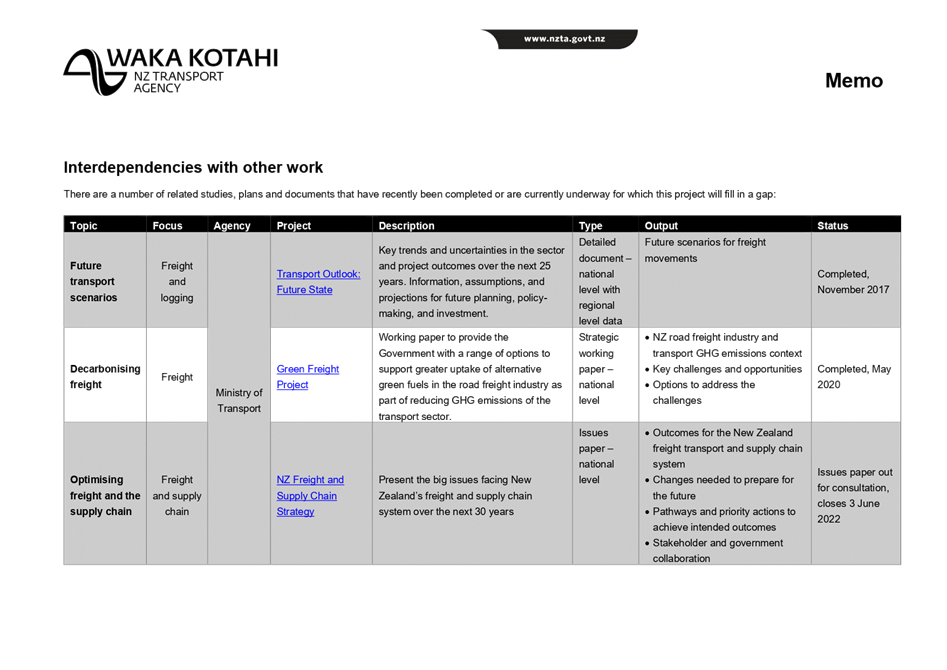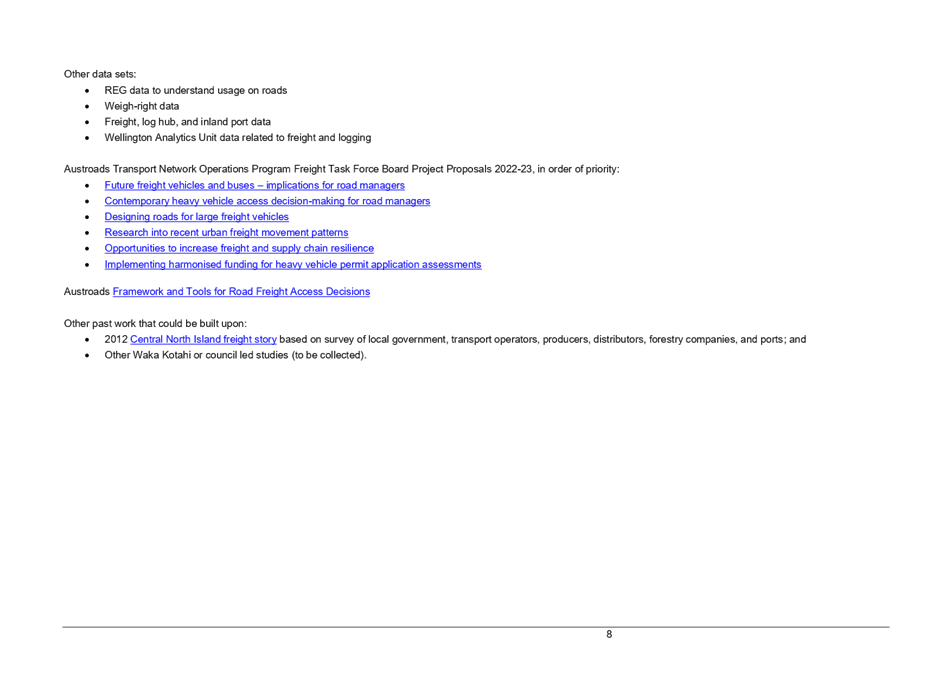Meeting of the
Regional Transport Committee
Date: 10 June 2022
Time: 10.00am
|
Venue:
|
Council
Chamber
Hawke's
Bay Regional Council
159
Dalton Street
NAPIER
|
Agenda
Item Title Page
1. Welcome/Notices/Apologies
2. Conflict
of Interest Declarations
3. Confirmation of Minutes of
the Regional Transport Committee meeting held on 11 March 2022
4. Follow-ups
from Previous Regional Transport Committee Meetings 3
5. Call
for Minor Items not on the Agenda 15
Decision
Items
6. Proposed
Public Transport Network Plan 17
7. Regional
Active Transport Committee 47
Information
or Performance Monitoring
8. Strategic
case for freight and logging 55
9. NZTA
Central Region - Regional Relationships Director's June 2022 Report 69
10. Transport
Manager’s June 2022 Report 95
11. Gisborne
Rail update 113
12. Verbal
Updates by Advisory Representatives
13. Discussion
of Minor Matters Not on the Agenda 119
Hawke’s Bay Regional Council
Regional
Transport Committee
10 June
2022
Subject: Follow-ups from previous
Regional Transport Committee meetings
Introduction
1. Attachment 1 is a list of
items raised at previous Regional Transport Committee meetings that require
action or follow-up. All follow-up items indicate who is responsible for each
item, when it is expected to be completed and a brief status comment. Once the
items have been completed and reported to the Committee they will be removed
from the lists.
Decision
Making Process
2. Staff have assessed the
requirements of the Local Government Act 2002 in relation to this item and have
concluded that, as this report is for information only, the decision-making
provisions do not apply.
|
Recommendation
That the Regional
Transport Committee receives and notes the Follow-ups from previous
Regional Transport Committee meetings.
|
Authored by:
|
Peter Martin
Senior Governance Advisor
|
|
Approved by:
|
Katie Nimon
Transport Manager
|
|
Attachment/s
|
1⇩
|
Follow-ups from previous meetings
|
|
|
|
Follow-ups from previous meetings
|
Attachment
1
|










Hawke’s Bay Regional
Council
Regional
Transport Committee
10 June
2022
Subject: Call for minor items not on the Agenda
Reason for Report
1. This item provides the
means for committee members to raise minor matters they wish to bring to the attention
of the meeting.
2. Hawke’s Bay Regional
Council standing order 9.13
states:
2.1. “A meeting may discuss an
item that is not on the agenda only if it is a minor matter relating to the
general business of the meeting and the Chairperson explains at the beginning
of the public part of the meeting that the item will be discussed. However, the
meeting may not make a resolution, decision or recommendation about the item,
except to refer it to a subsequent meeting for further discussion.”
Recommendations
3. That the Regional Transport
Committee accepts the following Minor items not on the agenda for
discussion as Item 13.
|
Peter
Martin
Senior
Governance Advisor
|
Katrina
Brunton
Group
Manager Policy & Regulation
|
Hawke’s Bay Regional Council
Regional
Transport Committee
10 June
2022
Subject: Proposed Public Transport Network Plan
Reason for Report
1. This item presents a
proposed new Public Transport Network Plan, which will form the basis of the
Regional Public Transport Plan (RPTP), and seeks feedback from the Committee
ahead of presenting it to the Regional Council for consideration and
incorporation into the RPTP for adoption for public consultation.
Background
2. Under the Land Transport
Management Act 2003 (LTMA), every Regional Council must adopt a Regional Public
Transport Plan unless it does not intend to enter into any contracts for the
supply of public transport services, or provide any financial assistance to any
operator or user of a taxi or shuttle service.
3. Hawke’s Bay Regional
Council’s Regional Public Transport Plan was last adopted in
April 2019, and was the first developed under the new LTMA requirements,
incorporating the principles of the Public Transport Operating Model. The
RTC assisted with the preparation of the plan, which must be adopted by the
Regional Council in accordance with the LTMA.
4. The Act states that an RPTP
must be reviewed and, if necessary, renewed or varied at the same time as, or
as soon as practicable after, the public transport components of a regional
land transport plan are approved or varied. As the Regional Land
Transport Plan has recently been reviewed and varied, it is timely for a review
of the RPTP.
5. The purpose of an RPTP is
to provide a public statement of:
5.1. the public transport
services that the Council considers integral to the network
5.2. the policies and
procedures, information and infrastructure that apply to those services.
6. Development and review of
an RPTP also provides an opportunity for public input into the design and
operation of the public transport network.
Review
Progress to date
8. Review progress is
contained within the attached memorandum.
Next
Steps
11. The Committee is asked to
provide any comment on the draft Public Transport Network Plan before it is
submitted for consideration by the Regional Council as part of the RPTP.
Once approved, it will be released for a full public consultation process in
August 2022.
Decision Making Process
12. Council and its committees
are required to make every decision in accordance with the requirements of the
Local Government Act 2002 (the Act). Staff have assessed the requirements in
relation to this item and have concluded:
12.1 The decision does not
significantly alter the service provision or affect a strategic asset, nor is
it inconsistent with an existing policy or plan.
12.2 This decision to endorse
the proposed Public Transport Network Plan is not significant under the
criteria contained in Council’s adopted Significance and Engagement
Policy.
12.3 The
use of a public consultation process by the Regional Council is prescribed by
legislation prior to adoption of a new Regional Public Transport Plan.
|
Recommendation
That the Regional Transport Committee:
1. Receives and considers
the Proposed Public Transport Network Plan staff report
2. Agrees that the decisions
to be made are not significant under the criteria contained in
Council’s adopted Significance and Engagement Policy, and that the
Committee can exercise its discretion and make decisions on this issue
without conferring directly with the community.
3. Endorses the Proposed
Public Transport Network Plan as amended in accordance with feedback
received on 10 June 2022.
4. Recommends that
Hawke’s Bay Regional Council adopts the draft Regional Public Transport
Plan, as
amended to incorporate the Proposed Public Transport Network Plan endorsed by the 10 June
2022 Regional Transport Committee meeting, for public consultation.
|
Authored by:
|
Katie Nimon
Transport Manager
|
|
Approved by:
|
Katrina Brunton
Group Manager Policy &
Regulation
|
|
Attachment/s
|
1⇩
|
MRCagney Memo re Public Transport
Network Review
|
|
|
|
2⇩
|
Proposed Public Transport Network
Map
|
|
|
|
MRCagney Memo re Public Transport Network
Review
|
Attachment
1
|
























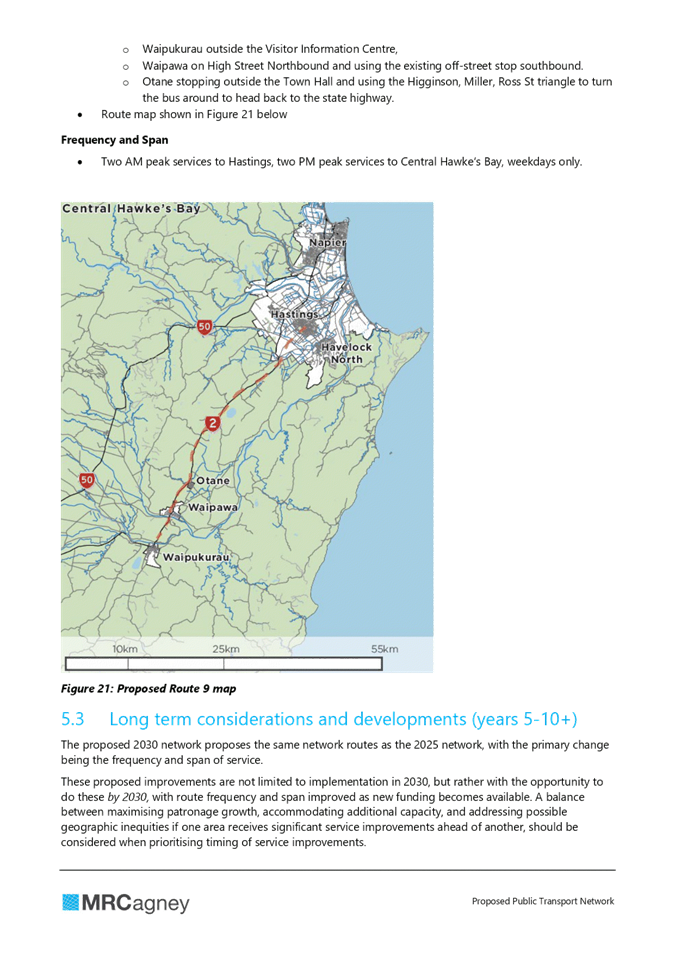
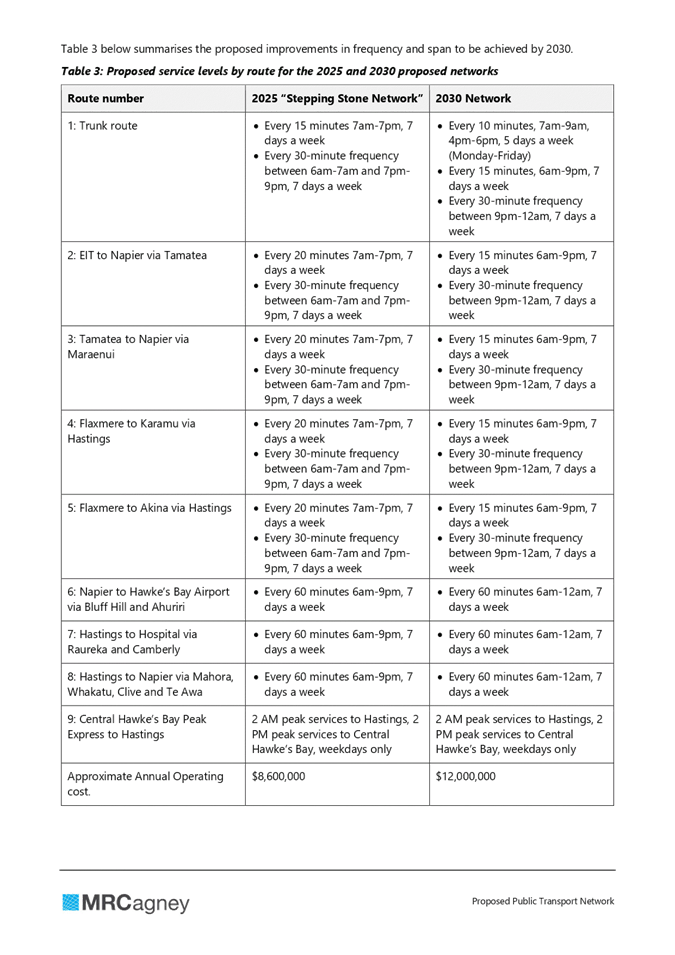
|
Proposed Public Transport Network Map
|
Attachment
2
|

HAWKE’S
BAY REGIONAL COUNCIL
Regional Transport Committee
10 June
2022
Subject: Regional Active Transport Committee
Reason for Report
1. This report proposes a new
governance structure for cycling as an active mode of transport. The intention
of the recommended proposal is to improve the governance function for Active
Transport, feeding into the Transport Technical Advisory Group (TAG). This
will contribute to improvements to Active Transport, allow the respective
committees more efficiency and allow for improved decision-making.
Officers’
Recommendations
2. Staff recommend that the
Regional Cycle Governance Group (RCGG) is dissolved and its members distributed
amongst a proposed new Hawke’s Bay Trails Steering Group, and the
respective Active Transport groups for Napier City Council (NCC) and Hastings District
Council (HDC) be merged to form a new Cycling and Active Transport Technical
Advisory Group (TAG).
Executive
Summary
3. This report proposes an
improvement to the current governance structure for active transport and
recreational cycling, being:
3.1. Active Transport Groups,
from HDC, NCC, WDC, and CHBDC, one representative each from Hawke’s Bay
District Health Board (HBDHB), and Bike On join the Regional TAG to ensure that
cycling and active modes of transport are integral to transport decisions and
technical advice provided to the RTC, or
3.2. Alternatively; Active
transport groups, from HDC, NCC, WDC, and CHBDC, one representative each from
Hawke’s Bay District Health Board (HBDHB), Waka Kotahi (NZTA), Bike On,
and Hawke’s Bay Regional Council (HBRC) come together to form a new
Cycling and Active Transport Technical Advisory group, or
3.3. In accordance with the
proposal from the existing members of the Regional Cycle Governance Group,
establish the Hawke’s Bay Regional Active Transport Committee with the
chair of the Committee being made an advisory and voting member to the Regional
Transport Committee.
4. The Regional Transport
Committee has full governing responsibility for a Hawke’s Bay transport
network that is vibrant, aqccessible and sustainable including active modes of
transport including cycling and walking.
5. The proposed changes will
ensure active transport groups, are connected to the Regional Transport
Advisory Group with more streamlined advice and reporting to the Regional
Transport Committee.
Background
/Discussion
6. The Regional Cycle
Governance Group, formed in August 2014, is a forum committed to providing safe
cycling for transport and recreation for local residents and visitors to
Hawke’s Bay. It
should be noted that while the Governance Group in name implies governance, it
was actually a working group and not a formally constituted Governance Group.
7. In 2014, Cycling did not
have a perceived place in Transport. The Group existed to ensure that those
organisations with roles in the provision of cycling engaged in a
collaborative, structured, transparent and strategic manner to ensure a
successful, integrated regional model.
8. Hawke’s Bay Regional
Cycle Plan 2021 outlines the region’s objectives, and who and how we will
maximise the social, environmental, and financial benefits from walking and
cycling. It is proposed that this document will be reviewed and updated by the
RTC as part of the Regional Public Transport Plan (RPTP).
9. The key differences between
the Hawke’s Bay Trails Great Ride and iWay networks are the user
experience, goals and funding. Although different values, they work closely
together to align and maximise the benefits of this regional network for
walking and cycling. It is critical that they align for connectivity.
10. In 2010 the Hawke’s Bay Regional
Council successfully attained $2.6M of government funding which HBRC, NCC, HDC
and Rotary Pathways Trust co-funded. The government funding was part of
the Ngā Haerenga, New Zealand Cycle Trail
(NZCT) national initiative to develop a network of world class cycling trails,
known as the Great Rides. These rides showcase the best of New Zealand’s
landscapes, environment, culture and heritage, creating a world class tourism
asset and visitor experience. Further MBIE funding was again received in 2019, with
co-funding from HBRC, HDC and NCC.
11. Led by Hawke’s Bay
Regional Council, the investment from Ministry of Business, Innovation and
Employment (MBIE) and local councils/Rotary Pathways Trust enabled development
of 186.3 km of trails known as the Hawke’s Bay Trails. These trails
are made up of three experiences: Landscapes, Wineries and Water Rides. The Hawke’s Bay Trails injects
$10.3M into the region’s economy from domestic tourism and a further
$1.89M from international tourism. A total of $12.19M annually.
12. As part of the requirements
for status/funding through MBIE to be a Great Ride under Ngā Haerenga (New
Zealand Cycle Trails), Hawke’s Bay Trails management needs to include:
12.1. a robust governance
structure. It is proposed that an HBRC-led Hawke’s Bay Trails Steering
Group be formalised with the Hawke’s Bay Trails MOU document underpinning
this Group. When meetings are held quarterly, the intention is to focus on the
Hawke’s Bay Trails goals as a recreation and tourism experience. This is
assessed yearly through a New Zealand Cycle Trail ‘Warrant of
Fitness’ that includes a section on Trail ownership and governance.
12.2. The Hawke’s Bay
Trails Steering Group would be led by HBRC with representatives from key
stakeholders HDC, NCC, HB Tourism and NZTA.
12.3. Safety and operations plans
meeting the standards of New Zealand Cycle Trail Inc.
13. The Hawke’s Bay
Trails Steering Group evolved to become broader than its original purpose and
this has led to some frustration that the group wasn’t able to interact
and influence the Regional Transport Committee or the Napier City Council and
Hastings District Council iWay or other council walking and cycling planning
and delivery in a coordinated way.
Proposed
approach from the Regional Cycle Governance Group
14. There is concern from the
members of the Regional
Cycle Governance Group that the Regional TAG and RTC do not adequately provide
for cycling and active modes of transport. As the current Regional Cycle
Governance Group is to be reformed to its original purpose, they have proposed
to establish a Regional Active Transport Committee and have set out a draft
Terms of Reference for the consideration of the Regional Transport Committee.
15. The group has proposed
their purpose to be to “influence and direct the development of a
direct, comfortable attractive, cohesive but most of all safe walking/ccling
network as a means of transport for local residents and visitors to
Hawke’s Bay. Recreational active transport is a subset but not
the main focus of the HBRATC objectives. It exists to advise those
organisations with roles in the provision of active transport to understand and
implement a successful, integrated regional active transport model. ”
16. The membership of the group
is proposed to include:
16.1. Local and Regional
Authorities (5) – one elected member from each authority
16.2. Hawke’s Bay District
Health Board – one member
16.3. Waka Kotahi - one member
16.4. Delegated members (3): HBRC
Transport Manager; BikeOn NZ Trust representative, Iwi representative from
Ngāti Kahungunu, Bike HB
16.5. Supporting Technical
Officers – one member of each respective council/regional authority (5),
involved with implementing council active transport plans
16.6. With a chair to be elected
by members after each triennial election that will report to the Regional
Transport Committee and have voting rights on the RTC.
17. The Terms of Reference note
that the Committee would not be a decision-making committee, except in respect
to its own activities and while its decisions would not be binding on any
associated organisation, “it is expected that any planning discussions
by member organisations will include input from the committee which in turn
will contribute to improved active transport infrastructure in the region,
including the iWays network, to ensure that there is a cohesive regional wide
plan and connected network. Any proposed new residential/commercial/industrial
development will require network planning, and to ensure that walking/cycling
infrastructure is considered, the RATC will need to be consulted on the
proposed transport infrastructure.”
18. The RATC is proposed to
have responsibility to prepare a Hawke’s Bay Regional Active Transport
Plan, to be part of the Regional Transport Plan.
Existing
Committees and Structures
19. The
Napier City Council and Hastings District Council iWay urban routes provide
safe cycle and walking paths focused on active transport for local communities.
These facilities include on-street cycle lanes as well as grade-separated
multi-use paths catering specifically for commuters, children cycling to school
and recreational cyclists connecting to the wider network. They attract
co-funding from Waka Kotahi NZTA.
20. Active Transport, as a mode
of transport including walking and cycling, is planned through the Regional
Land Transport Plan and funded by Waka Kotahi. Governance of these activities
is by the RTC. Planning and advice for active transport currently comes
to the RTC from the Regional TAG and submissions made through consultation
phases of the Regional Land Transport Plan.
21. The current Regional
Technical Advisory Group includes membership from NCC, HDC, WDC, CHBDC, HBRC,
Waka Kotahi and includes officers that are on existing Active Transport
Committees within those organisations.
22. The Regional Cycle
Governance Group includes mostly the same membership of NCC, HDC, HBRC, CHBDC,
WDC, Waka Kotahi, but also includes the DHB and BikeOn. The only
organisations currently not on the Regional TAG is DHB and Bikeon, noting
BikeOn is not currently active members of the Regional Cycle Governance Group.
23. It is essential that
membership of the current Regional Technical Advisory Group includes active
transport members from these organisations and could easily include additional
members into the Regional TAG to ensure the members of the Active Transport
Committees are representatives on the Regional TAG.
24. The Regional Land Transport
Plan vision that Hawke's Bay’s transport network fosters a vibrant,
accessible and sustainable carbon neutral Hawke’s BayTransport Mode shift
requires integration of the Active Transport Committees, DHB and other
interested organisations such as Bikeon into the Regional TAG to ensure that
cycling and active modes of transport are integral to transport planning.
25. The Regional Transport
Committee is responsible for ensuring the outcomes ro reach the vision aim to:
25.1. Achieve a safe transport
system for users
25.2. Achieve a transport network
that is resilient, reliable and efficient
25.3. Provide transport choices
to meet social, environmental and cultural needs
25.4. Develop a transport system that
contributes to a carbon neutral Hawkes Bay
25.5. Minimise travel demand
through planning and development.
26. Achieving these outcomes
requires an integrated transport planning approach. The concern is that if a
separate Regional
Active Transport Technical Advisory group or Committee is formed, it will essentially
replicate the Regional Transport Committee.
27. Officers recommend, an
integrated and collaborative approach to incorporating active modes of
transport into the Regional TAG and the RTC. Adding representatives from
the Active Transport Committees of the TLAs, DHB and Bikeon and/or other
cycling advocacy groups into the Regional TAG and committing to reviewing the
Terms of Reference for the Regional Transport Committee to include another
elected representive as a voting member specifically for the purposes of
representing active modes of transport.
28. Alternatively, if the
Regional Transport Committee agrees with the proposal put forward by the
current members of the Regional Cycling Governance Group to establish a
Hawke’s Bay Regional Active Transport Committee, the Terms of Reference
for the Regional Transport Committee will need to be reviewed to enable its
representative to be an advisory and voting member on the RTC.
29. Active transport must form
part of the Regional Land Transport Plan and be part of any future transport
proposal, programme or business case in that plan to be considered for Waka
Kotahi funding. Having a separate Regional Active Transport Plan
undermines the multi modal approach that the Regional Transport Committee have
agreed in the Regional Land Transport Plan. Officers do not support a separate
the preparation of a separate Regional Active Transport Plan if a separate
committee is to be established.
Strategic Fit
30. This item proposes to
better integrate active modes of transport into the Region’s Transport
Planning, contributing to:
30.1. By 2025, regional air
quality consistently meets World Health Organisation Guidelines
30.1.1. By redefining the cycling
governance structure, active transport will see improved efficiency in
governance and management, and thus better consideration as a mode of transport
as part of a regional transport network and plan.
30.2. By 2025, HBRC is carbon
zero and plays a leadership role in the region’s goal of net zero
greenhouse gases by 2050
30.2.1. To achieve net zero
greenhouse gases, cycling and active transport need to be part of the transport
plan to promote low-impact transport and energy reduction solutions.
Financial
and Resource Implications
31. There are not anticipated
to be any financial implications as a result of the proposed new governance
model.
Consultation
32. This matter was discussed
at the last Regional Cycling Governance Group meeting on 23 November 2021
and flagged at the 3 December 2021 RTC meeting to be addressed in the March
2022 RTC meeting.
Other Considerations
33. Currently, those involved
in the RCGG have no delegated authority to act upon decisions made in this
forum. Agenda items are required to be brought to the RTC for decision making.
As a result, cycling and active transport has lacked representation at an
officer and governance level, as there has been no clear decision-making
process.
Decision Making Process
34. Council and its committees
are required to make every decision in accordance with the requirements of the
Local Government Act 2002 (the Act). Staff have assessed the requirements in
relation to this item and have concluded:
34.1. The decision does not
significantly alter the service provision or affect a strategic asset, nor is
it inconsistent with an existing policy or plan.
34.2. The use of the special
consultative procedure is not prescribed by legislation.
34.3. The decision is not
significant under the criteria contained in Council’s adopted
Significance and Engagement Policy.
Recommendations
That the Regional Transport Committee:
1. Receives and considers the Formalising
active transport representation on HB Regional Transport Committee staff
report.
2. Agrees that the decisions
to be made are not significant under the criteria contained in Council’s
adopted Significance and Engagement Policy, and that the Committee can exercise
its discretion and make decisions on this issue without conferring directly
with the community.
3. Agrees to:
3.1. Include the respective
Territorial Local Authority Active Transport committees into the Regional
Transport Technical Advisory Group
OR
3.2. Establish a new Technical
Advisory Group specifically for cycling and active modes of transport
OR
3.3. Establish the Hawke’s
Bay Regional Active Transport Committee with the chair of the Committee being
an advisory and voting member on the Regional Transport Committee
and
3.4. Amends the Terms of
Reference for the Regional Transport Committee to include an Active
Transport/Cycling advisory and voting Member.
Authored
by: Approved
by:
|
Katie Nimon
Transport Manager
|
Katrina Brunton
Group
Manager Policy & Regulation
|
Attachment/s
|
1⇩
|
draft Regional Active Transport
Committee Terms of Reference
|
|
|
|
draft Regional Active Transport Committee
Terms of Reference
|
Attachment
1
|

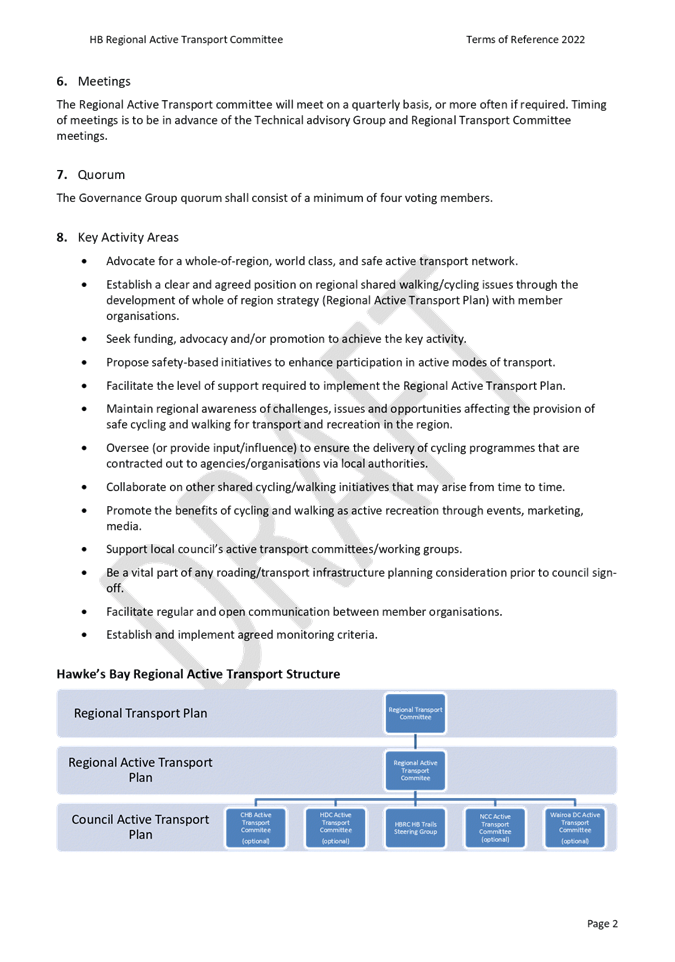
Hawke’s
Bay Regional Council
Regional
Transport Committee
10 June
2022
Subject: Strategic case for freight and logging
Reason for Report
1. This item updates the
central North Island Logging and Freight Strategic Study and provides an
opportunity for feedback and discussions on how we work together
collaboratively to progress it.
Executive Summary
2. The logging industry has a
significant impact on our collective transport system across the central North
Island. Waka Kotahi is proposing a structured approach to managing the
increased levels of use over the next 10 – 20 years, that empowers Waka
Kotahi and its funding partners (RCAs) to proactively maintain and operate key
strategic routes utilised primarily by logging and other heavy freight
companies. Waka Kotahi is seeking support for this approach from the
Hawke’s Bay Regional Transport Committee (HBRTC), alongside neighbouring
regions in the central North Island.
Background
3. As part of discussions with
funding partners across the central North Island, one of the most significant
concerns regularly raised with Waka Kotahi is the impending impact of increased
forestry harvesting expected over the next 10-20 years. Combined with
resilience and the impact of logging freight on levels of service, safety, and
efficiency on both the local road and state highway network, there is a need
for a step change across the region in how we collectively manage and operate
our key strategic routes to the ports. This ultimately impacts on the transport
system outcomes agreed on in the RLTP 21-24.
4. While there have been many
studies completed on this issue in various parts of the region, there has not
been a study covering the entirety of the projected impact to the regional
network.
5. A memo outlining the
approach Waka Kotahi wishes to progress is attached to this paper.
6. Waka Kotahi would like to
engage with key personnel from each council to contribute to Stages 2, 3 and 4
described in the memo.
7. Waka Kotahi would then like
to present initial insights to the Hawke’s Bay RTC at their next meeting
for feedback that would assist in the forming of the study report.
8. The strategic case will
recommend a pathway for next steps (potentially a programme business case),
funding and involvement from the wider logging/freight sector.
Discussion
9. Does the Hawke’s Bay
RTC agree with the context of the study? Is there anything missing?
10. Is the Hawke’s Bay
RTC comfortable with the proposed approach and the involvement of their
councils?
11. What level of involvement
is required of the Hawke’s Bay RTC?
Next Steps
12. Engage with partners as
discussed in the attached document.
Decision Making Process
13. Staff have assessed the
requirements of the Local Government Act 2002 in relation to this item and have
concluded that, as this report is for information only, the decision-making
provisions do not apply.
Recommendation
That the Regional Transport Committee
receives and notes the Strategic case for freight and logging report.
Authored by:
Approved by:
|
Linda Stewart
Waka Kotahi
|
|
Attachment/s
|
1⇩
|
Strategic case for freight and
logging
|
|
|
|
2⇩
|
CNI forestry study memo-council
feedback
|
|
|
|
Strategic case for freight and logging
|
Attachment
1
|
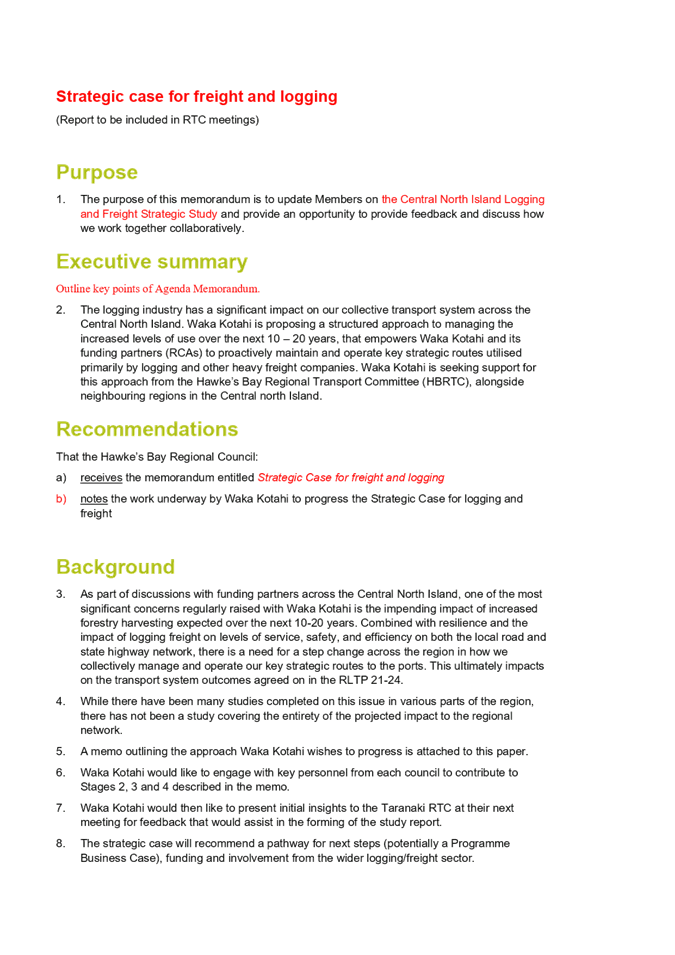

|
CNI forestry study memo-council feedback
|
Attachment
2
|
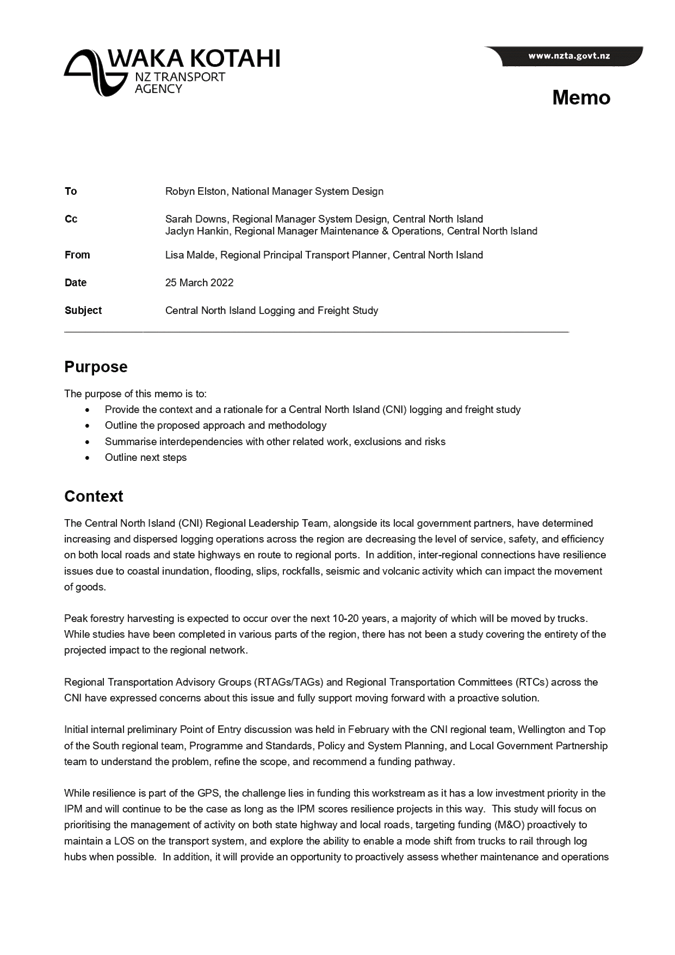

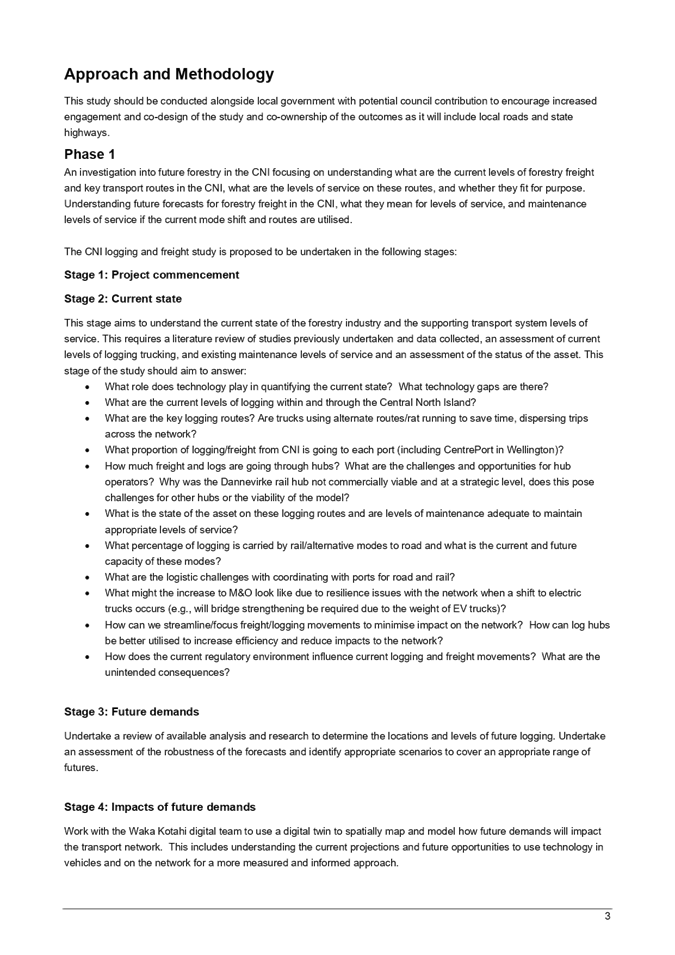

Hawke’s
Bay Regional Council
Regional
Transport Committee
10 June 2022
Subject: NZTA Central Region - Regional Relationships Director's
June 2022 Report
Reason for Report
1. This item introduces the
NZTA Central Region Regional Relationships Director’s report.
Decision Making Process
2. Staff have assessed the
requirements of the Local Government Act 2002 in relation to this item and have
concluded that, as this report is for information only, the decision-making
provisions do not apply.
|
Recommendation
That the Regional
Transport Committee receives and notes the NZTA Central Region –
Regional Relationships Director’s June 2022 report.
|
Authored by:
|
Katie Nimon
Transport Manager
|
|
Approved by:
|
Katrina Brunton
Group Manager Policy &
Regulation
|
|
Attachment/s
|
1⇩
|
Waka Kotahi Presentation June 2022
|
|
|
|
2⇩
|
Waka Kotahi Update
|
|
|
|
Waka Kotahi Presentation June 2022
|
Attachment
1
|
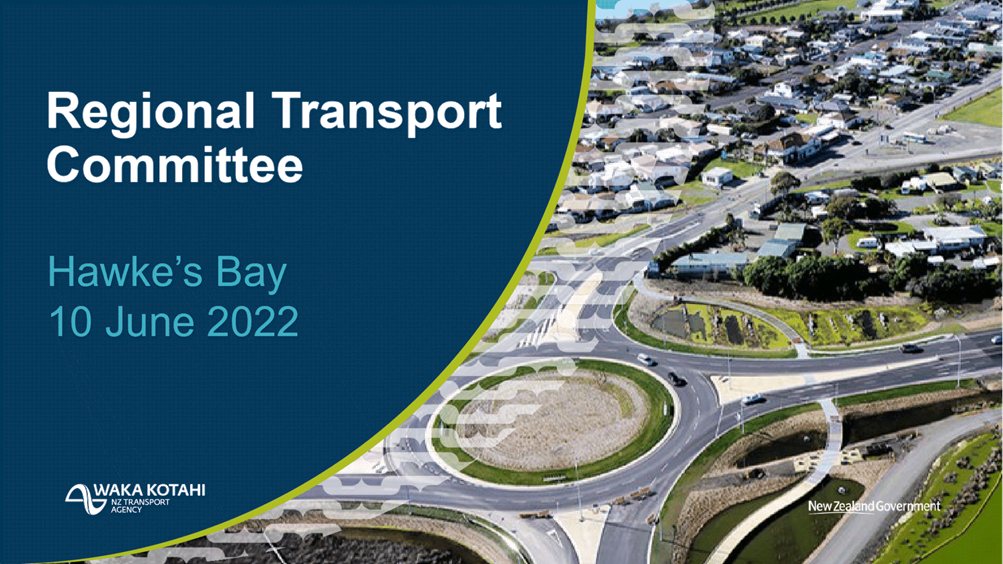
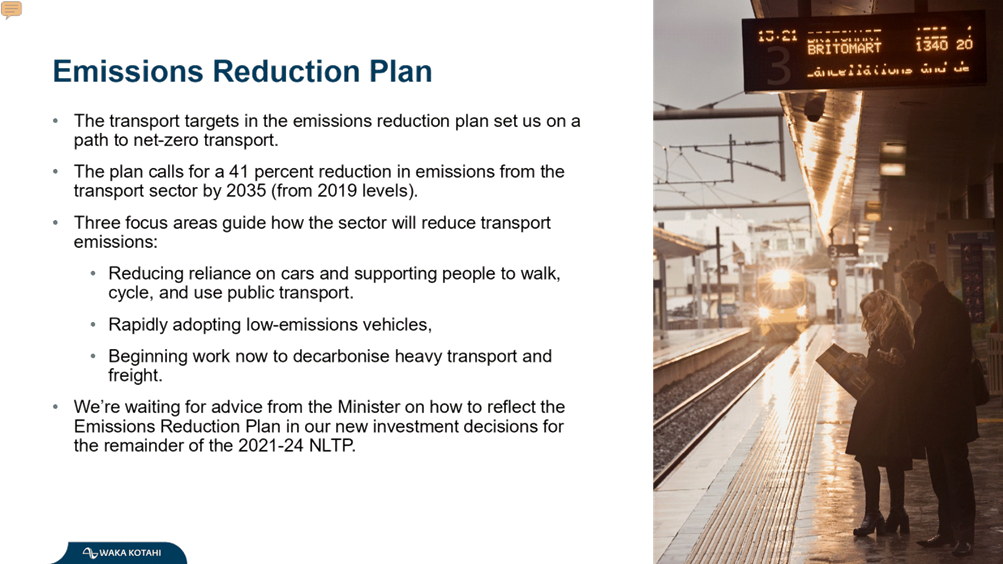
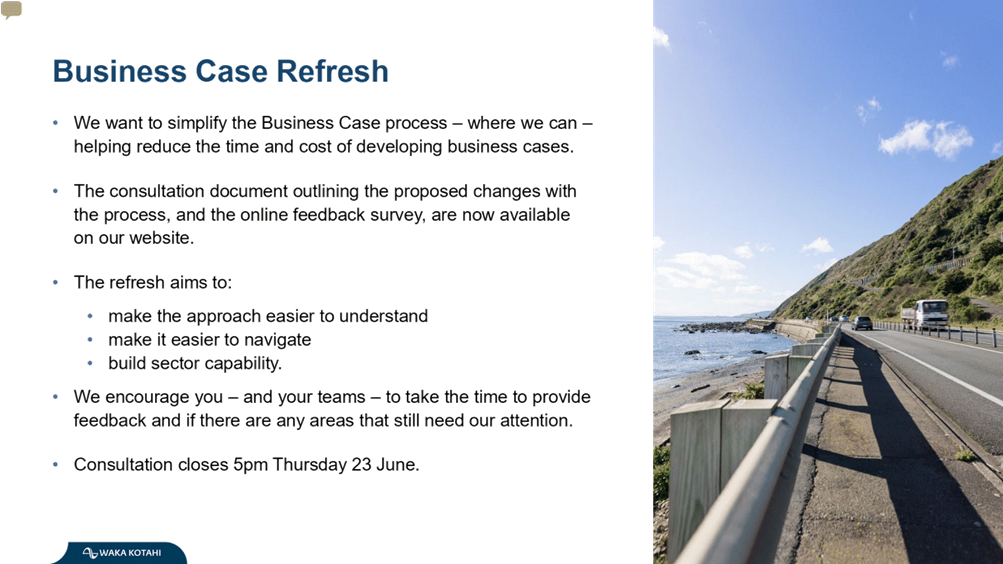

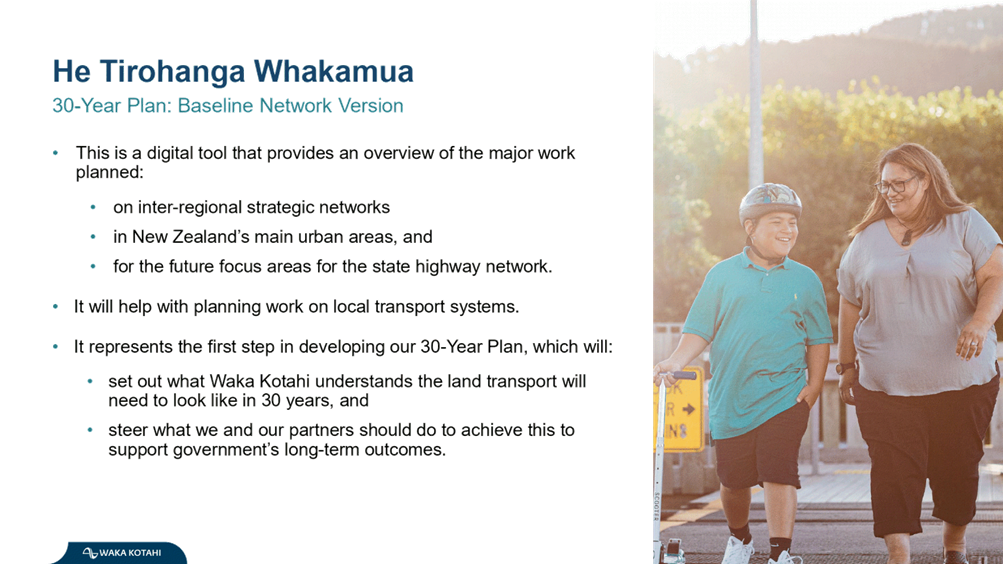
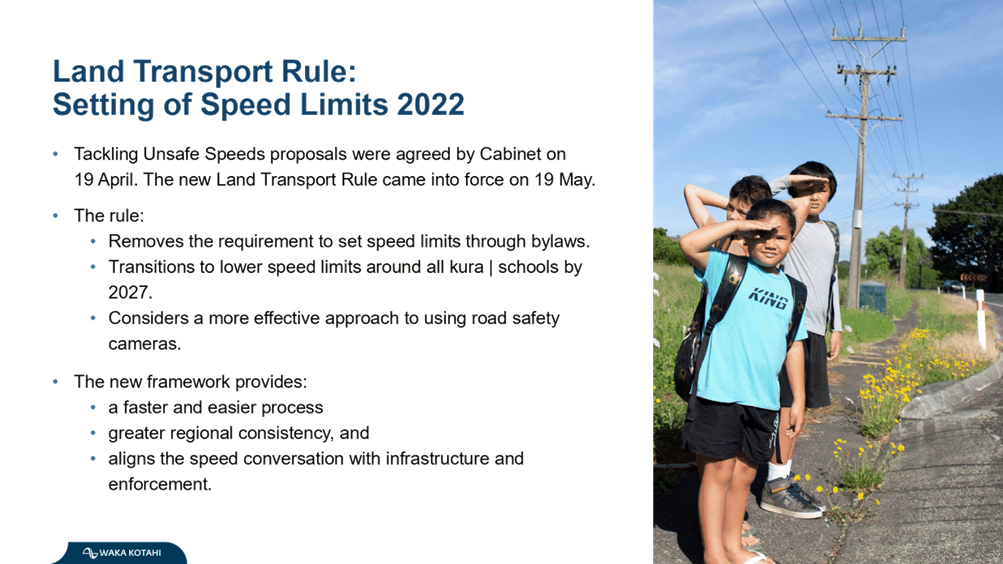
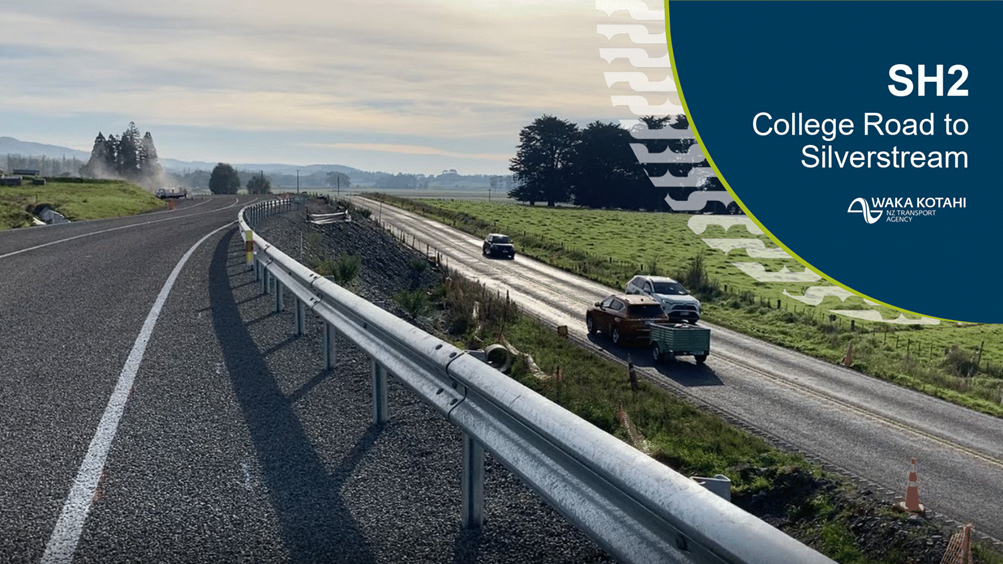
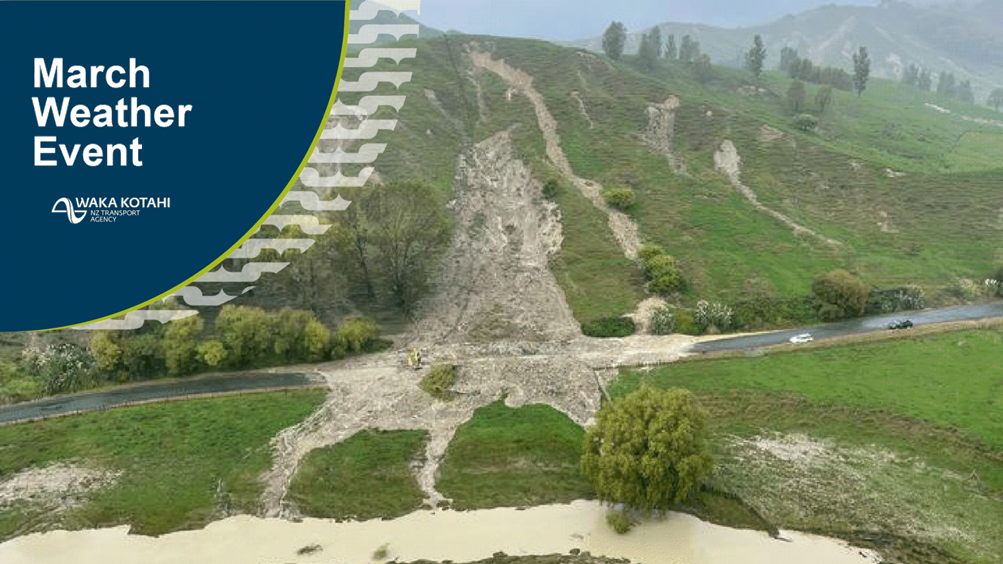
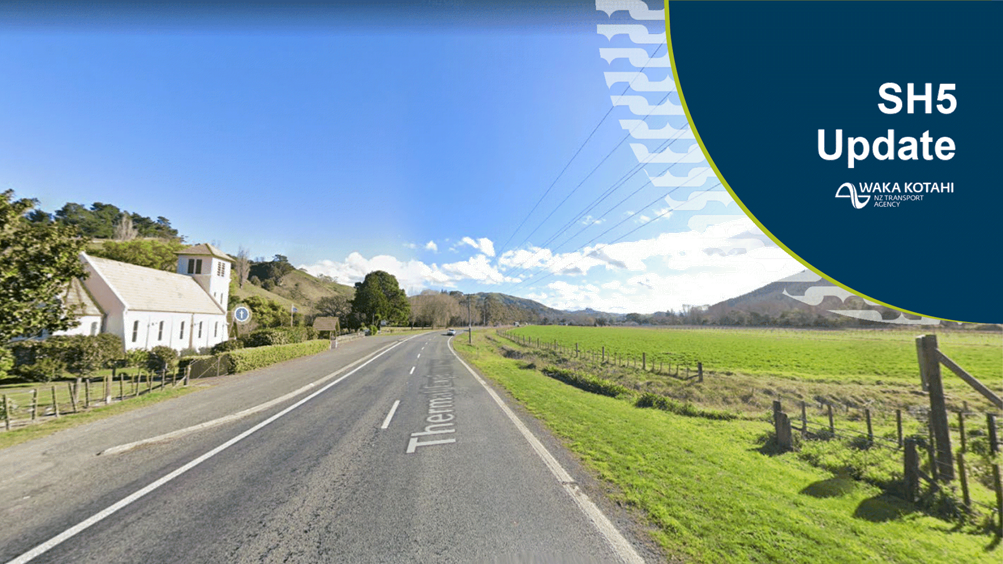
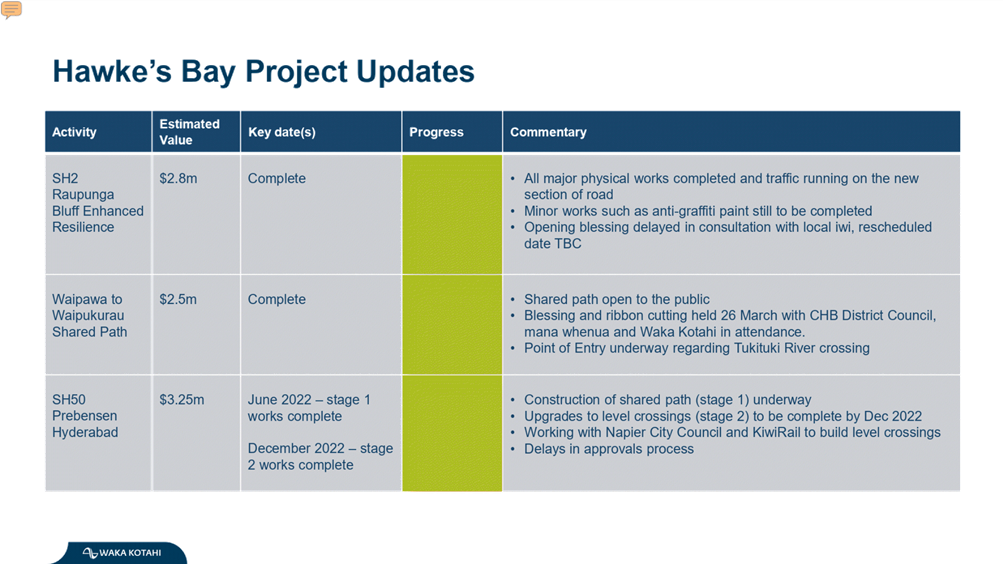

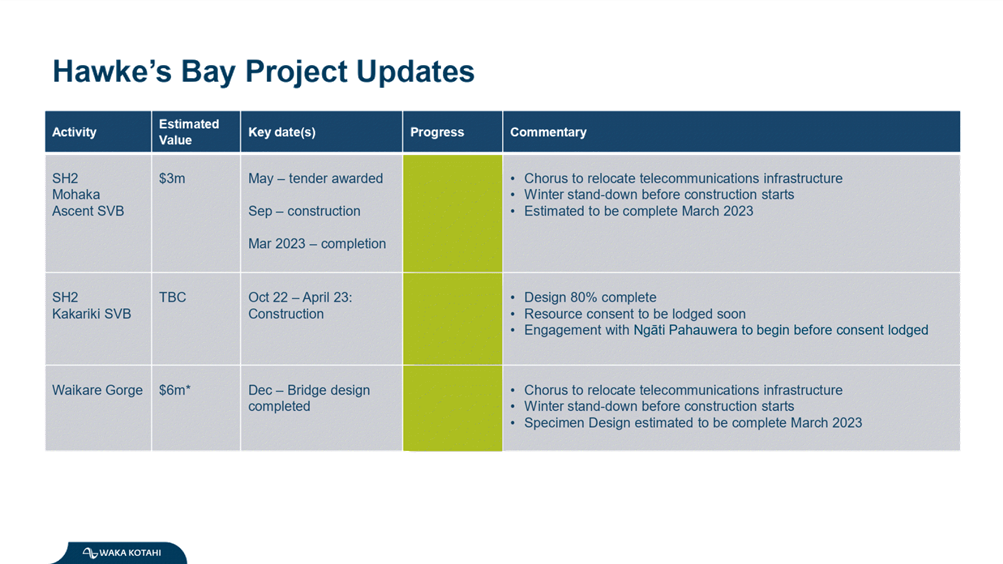
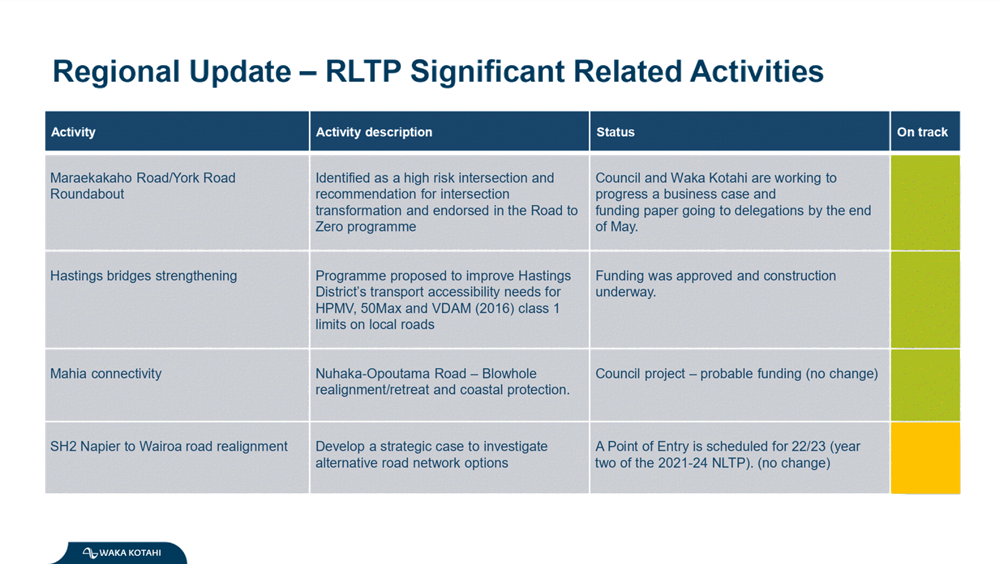
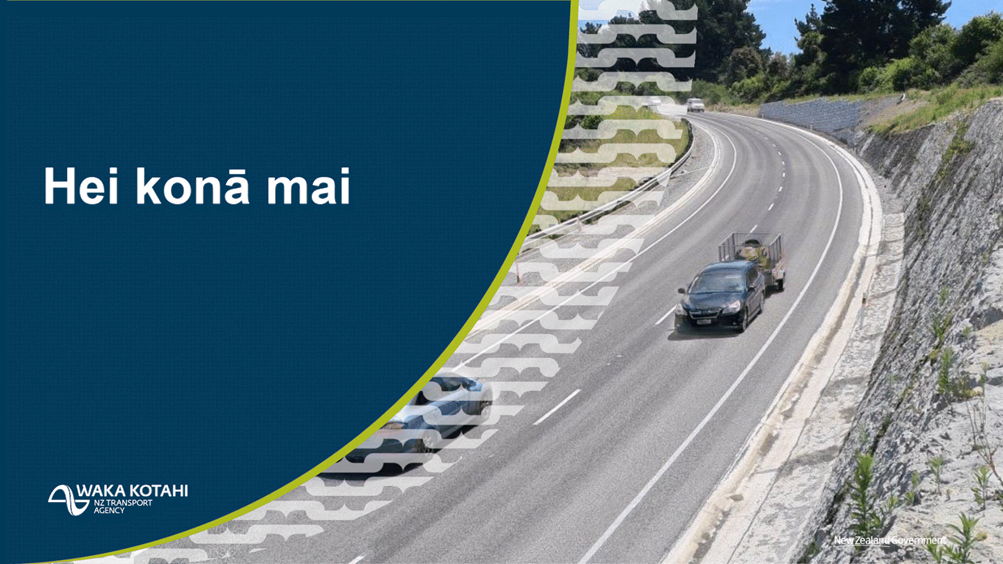
|
Waka Kotahi Update
|
Attachment
2
|
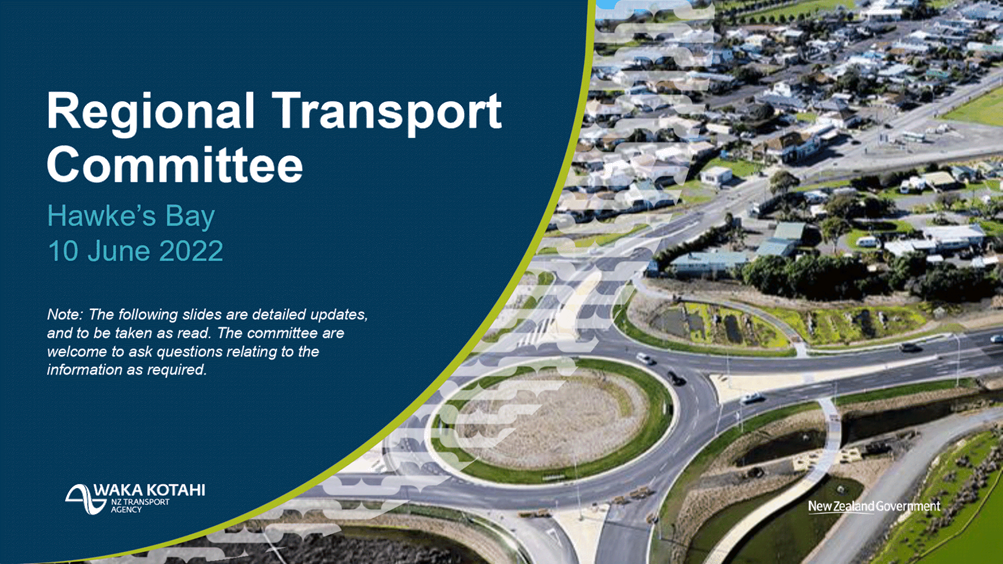

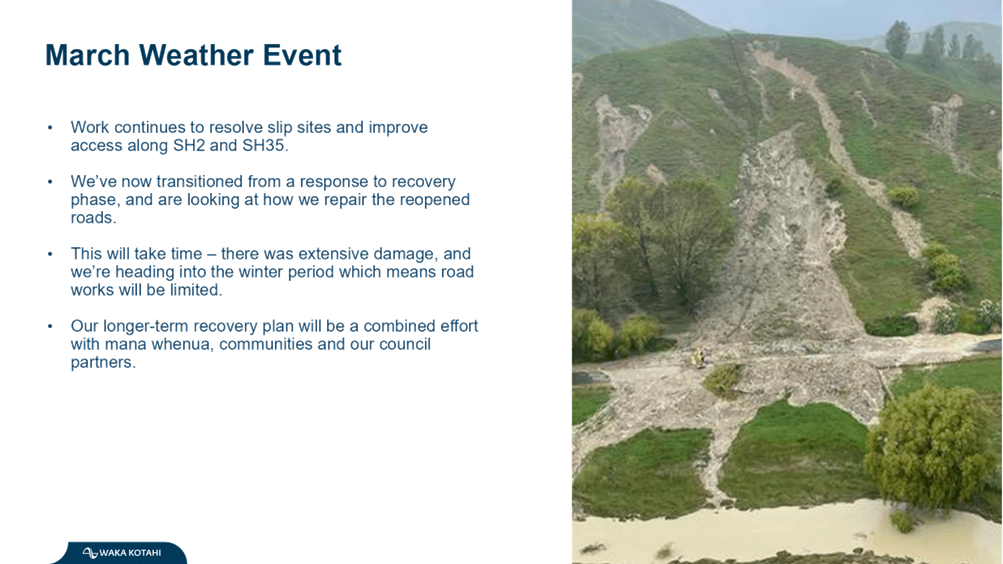

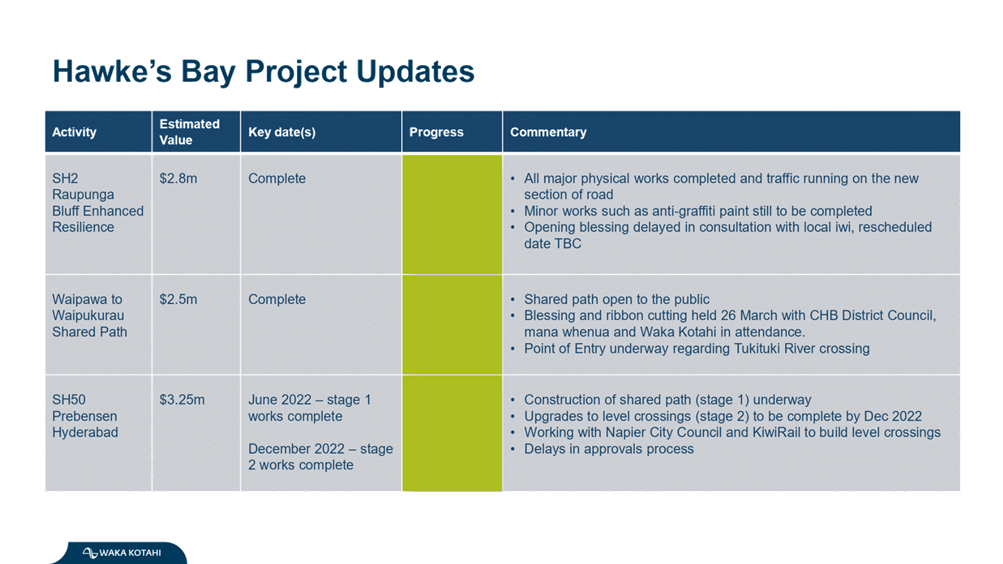


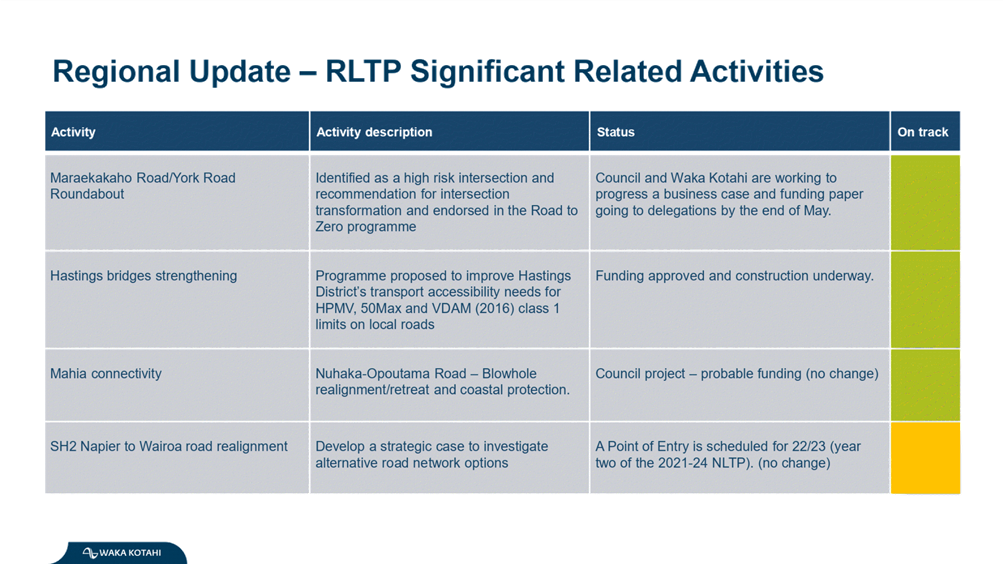
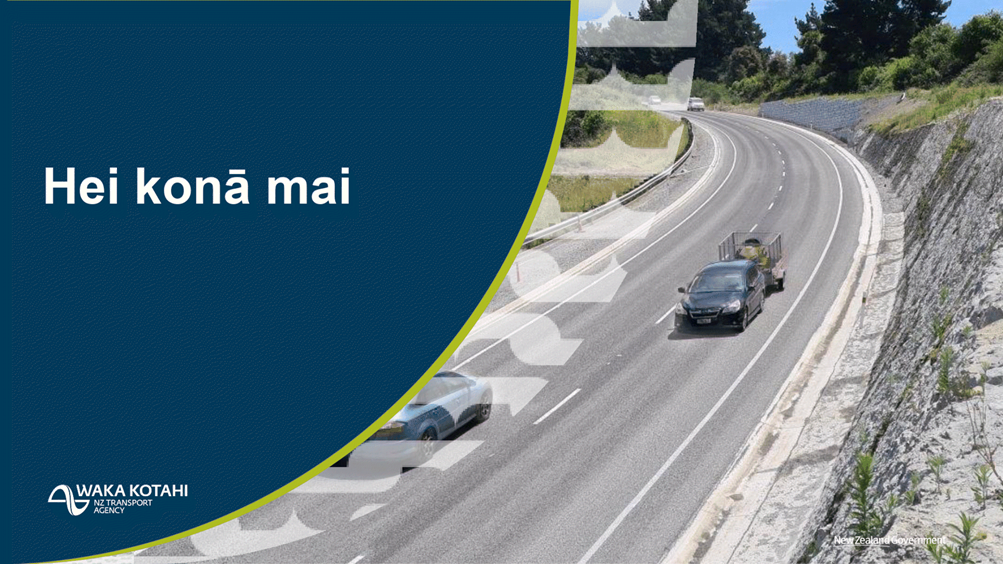
Hawke’s Bay Regional
Council
Regional
Transport Committee
10 June
2022
Subject: Transport Manager’s June 2022 Report
Reason for report
1. This report provides the
committee with a snapshot of relevant transport matters, including current national and local
issues and work programmes from Waka Kotahi, Ministry of Transport, Ministry
for the Environment and Ministry of Education, the Passenger Transport
Network/Service Review, Subsidised Passenger Transport, On Demand Public
Transport, the Total Mobility Scheme (including the Ridewise project), Road
Safety Promotion, the Driver Licensing Programme, Transport Special Interest
Group (TSIG) workstreams
and the Transport Advisory Group (TAG).
Discussion
Network/service review and Regional
Public Transport Plan (RPTP)
2. The public transport
network review is now complete. The Network Plan (detailed in a separate
report) has been workshopped with the RTC. MRCagney has developed the proposed
network plan with input from the HBRC transport team as well as multiple levels
of data including current public transport statistics, commuter movements,
population growth, district plans, and national policy.
3. Once approved in principle
by the RTC, the network plan will be presented to the 29 June Regional Council
meeting for approval to be incorporated into the RPTP and proceed to public
consultation, planned for August 2022.
Subsidised
passenger transport
4. As a result of rising fuel
prices, the Minister of Transport announced a government fund to reduce public
transport fares by 50% until the end of June. Waka Kotahi has worked with
public transport authorities to implement this scheme, which has involved temporary
amendments to tariff policies, and public marketing and communications. The
half-price fares scheme has now been extended to the end of August. From the 1
September 2022, fares for Community Service Card holders will remain discounted
at 50% and will increase to full price for all other users. The discount is
provided by Crown funding, and the loss of fare revenue is invoiced to Waka
Kotahi by HBRC.
5. On 23 May, Go Bus resumed
operating the full goBay timetable after operating a reduced service since 14
February. The reduced service was a result of a driver shortage that saw an
increasing number of cancelled services from the beginning of January. The
decision was made to reduce the timetable to ensure that the trips that could
be offered, were done so reliably for the public, to avoid daily unexpected
cancellations. Since the full service resumed on 23 May, there have been 32
cancelled trips.
On
demand public transport (ODPT)
6. The MyWay service launched
publicly on 7 June, after a two-week test period, with a group of 100 test
users. These champions trailled the service for free, providing valuable
feedback that allowed any issues to be resolved or improved before the public
launch. The trial will operate for 12 months in Hastings - replacing routes
16a, 16b, and 17 - to find out if the new style of public transport works for
the Hastings community, and results in a patronage increase. If the trial is a
success, it will be trialled in Napier.
7. MyWay has experienced
supply chain issues with the supply and manufacture of vehicles, resulting in a
delayed delivery of the accessible vehicle for the service. As a result, Go Bus
are operating the on-demand service with a 32-seat bus, to ensure the service
remains wheelchair accessible until the low floor van arrives.
8. The service already had 316
registered users, before MyWay launched to the public.
9. The service will operate
with a $2 fare, for all rides from anywhere in Hastings. This is the same price
as an hour of on-street parking in the Hastings CBD, which reinforces the
benefit of reducing short distance car trips. It is worth noting that Hastings
has announced that parking will be free for the month of July. Super Gold and
child concessions apply. From 1 September, the community services card half
price concession will apply.
Total
Mobility and the Ridewise project
10. The Total Mobility Scheme
is also operating under the half-price fares scheme, which has now been
extended to the end of August. This has resulted in an increase in trips during
this period. The budget announcement to continue to halve fares for those with
Community Service Cards, has not been extended to the Total Mobility Scheme.
11. The Ridewise project is
scheduled to go live on 1 July. All members have been advised of the change,
although there is minimal disruption to their experience. They will receive
their new ID cards in June, which will be their access to discounted fares.
They will no longer require vouchers. All transport operator technology is now
compatible, and the final training is to take place on 22 June. The intention
of this technology is to reduce the potential for fraudulent activity, reduce
administrative processes, and increase the independence of members.
12. The project has resulted in
an update of data, and our latest membership is approximately 3500. Once the
platform is live, we will be able to provide information on the number of
active users.
Road
safety
13. The Road Safety Expo 2022
has operated as a virtual event due to the physical event being cancelled due
to Covid restrictions. This is a new format and was supported by an agency that
specialises in virtual events. While it has been difficult to get schools to
commit to attendance, the Council can now offer a recorded interactive resource
at any time of the year. The Council has also delivered messaging through a
social media campaign, targeting the expo audience to further reinforce the
messaging. While we are yet to receive feedback, this delivery method is well
suited to the learning style of the attendees and improves accessibility for
schools outside of the Napier/Hastings area.
14. The s17a review has been
completed by Morrison Low, endorsed by the RTC and approved by the FARS
Committee. Work has now begun on implementing the change.
15. New Zealand Road Safety
week was held May 9-13. There were many activities in the Hawke’s Bay
community during that week, across all areas of Road Safety. The
Council’s Road Safety coordinator was out in the community all week,
attending events and delivering presentations.
16. This quarter, the
Council’s Road Safety coordinator has delivered:
16.1. Easter road safety fatigue
checkpoints in partnership with NZ Police
16.2. Rangatahi community
programmes
16.3. Preparation and delivery of
the Youth Road Safety Virtual Expo
16.4. Community partnership
16.5. Facilitating and supporting
partnership programmes such as Ride Forever.
Driver
licensing programme
17. The contracted Driver
Licensing Programmes are continuing to deliver driver licensing across the
region and are now all providing services funded at 100% of costs, removing the
cost barrier for all learners. The end of the contract term is 30 June 2022.
18. The Council and Waka Kotahi
have discussed the future of the Driver Licensing Programme and agree that our
regions’ high number of adult learners and restricted license holders
should be addressed. This is a growing number and could be considered for a future
Driver Licensing Programme funded by Waka Kotahi and HBRC.
19. Funding for a Driver
Licensing Programme for the 2022-2023 financial year is yet to be confirmed.
Speed
management plan
20. Waka Kotahi has introduced
a new rule. Land Transport Rule: Setting of Speed Limits 2017 has replaced the
previous rule.
21. The aim is to achieve
greater regional consistency and ensure decisions about speed limit changes are
made in alignment with infrastructure improvements.
22. Speed management planning
will now become part of a three-year cycle that aligns with the RLTP process.
The inclusion of speed management planning in the RLTP supports the
Council’s preferred approach to road safety promotion - being represented
within the RLTP alongside infrastructure investment decisions.
23. Setting school speed limits
are the priority – there is a target of 40% of speeds around schools
being reduced by 2024, with the remainder being completed by 2027.
24. The rule removes the
requirement to set speed limits through bylaws, however all speed limits will
need to be entered into a national register which will give legal effect to all
non-temporary speed limits.
25. The rule requires public
consultation to be facilitated by the Regional Council.
Emissions
reduction plan
26. MfE has released NZ’s
first Emissions Reduction Plan as required under the Climate Change Response
Act 2002. The Transport Special Interest Group (TSIG) has sent a submission on
the document, only commenting on the transport section of the plan. HBRC has contributed
to this, and the submission was supplied to the RTC at the December meeting.
27. The RLTP contains vision
and objectives aimed at reducing transport emissions through increased use of
public and active transport, increased use of rail for freight and integrated
land use planning that reduces reliance on private vehicles. The newly
developed ERP presents an opportunity to get strong national alignment and
allow “the changing of hearts and minds” to be influenced at a
central Government level. Our focus must now be on alignment and integration of
district and regional planning to ensure targets are met was a region.
28. The plan sets a total 41%
reduction target for transport emissions, and within that, a 20% reduction in
vehicle kilometers travelled (VKT). This will require a shift to PT and active
modes of transport.
29. Waka Kotahi is currently
reviewing the Investment Decision Making Framework (IDMF) to better consider
climate change.
30. The Ministry of Transport
has developed key transport actions to achieve emissions reductions across
freight, fuel, and decarbonisation of vehicles, as well as the increased use of
active modes and the reach, frequency, and quality of public transport.
Travel
demand management (TDM)
31. The TSIG has established a
TDM working group, which HBRC has representation. Work is already underway to
find examples of best practice internationally and success stories in the
public engagement space. As with the submission on the ERP, the focus of this
group is Avoid Shift Improve (ASI). The TDM group is also very aware of the
different issues presented within the regions, such as a lack of congestion and
motivation to seek a shift in modes, given that for many of the territorial
authorities parking is a priority. Integrated spatial planning plays a role in
this, as does education and engagement.
32. The current student
movement for free fares for anyone under 25, is collectively believed to not
support Mode Shift. The movement was about social good rather than transport
outcomes, and most regions would see around a 30% reduction in their fare
revenue. Ultimately, if under-25s can travel for free, it’s believed that
people who might have traditionally walked or cycled will take public transport
for shorter trips instead of switching people who might have otherwise
travelled by car to travel by bus. Some regions are opting to review their fare
policies rather than react to the free fares movement because of this.
Ministry
of Education school bus network
33. The Ministry of Education
has announced that the Waipawa to Hastings school bus service will no longer be
accessible to ineligible students who made up roughly 75% of passenger numbers.
This affects students travelling to Hastings Boys High School, Hastings Girls
High School, Te Kura Kaupapa Māori o Ngati Kahungunu Ki Heretaunga, and
Karamu High School.
Regional Land Transport Plan (RLTP)
investment and delivery issues
34. The Technical Advisory
Group (TAG) meeting was held on 12 May 2022. The agenda included presentations
from Waka Kotahi on Speed Management Planning, and further funding for road
safety promotion on state highways.
35. Approved organisation RLTP
investment and delivery updates were written by each territorial authority and
distributed to TAG members prior to the meeting. This template was provided by
Waka Kotahi and is currently in use in Taranaki. The success of these updates
has seen the Taranaki RTC now include them as items on their agenda, talked to
by each territorial authorities’ elected member. In this instance, the
reports are attached for discussion.
Decision making process
36. Staff have assessed the
requirements of the Local Government Act 2002 in relation to this item and have
concluded that, as this report is for information only, the decision-making
provisions do not apply.
|
Recommendations
That
the Regional Transport Committee receives and considers the Transport Manager’s June 2022 report.
|
Authored
by: Approved
by:
|
Katie Nimon
Transport Manager
|
Katrina Brunton
Group
Manager Policy & Regulation
|
Attachment/s
|
1⇩
|
CHBDC forward work programme May
2022
|
|
|
|
2⇩
|
HDC forward work programme May 2022
|
|
|
|
3⇩
|
NCC forward work programmeMay 2022
|
|
|
|
4⇩
|
WDC forward work programme May 2022
|
|
|
|
CHBDC forward work programme May 2022
|
Attachment
1
|
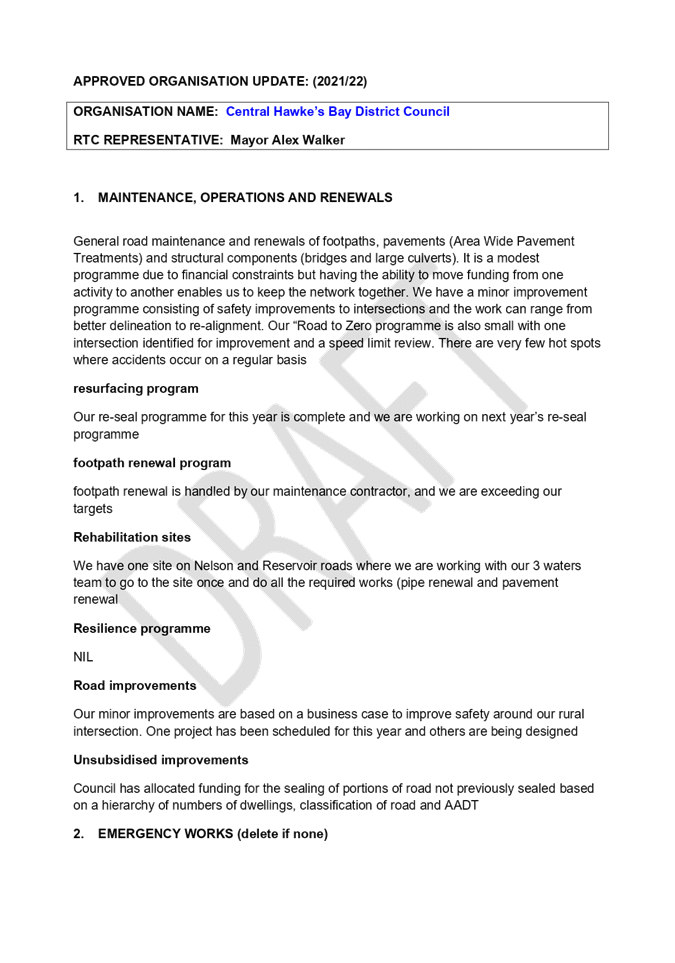
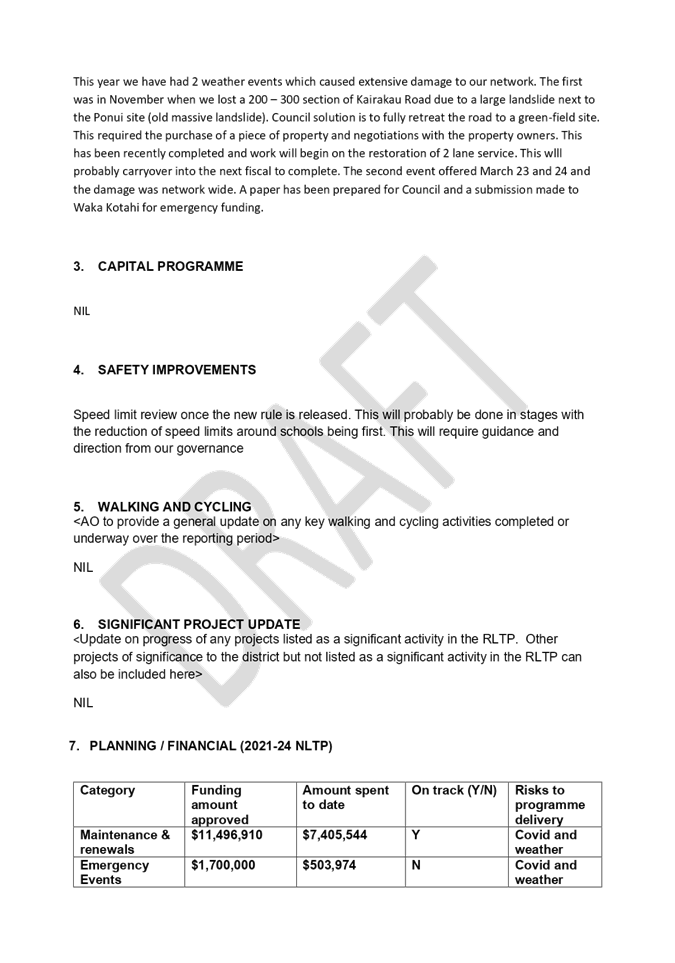

|
HDC forward work programme May 2022
|
Attachment
2
|
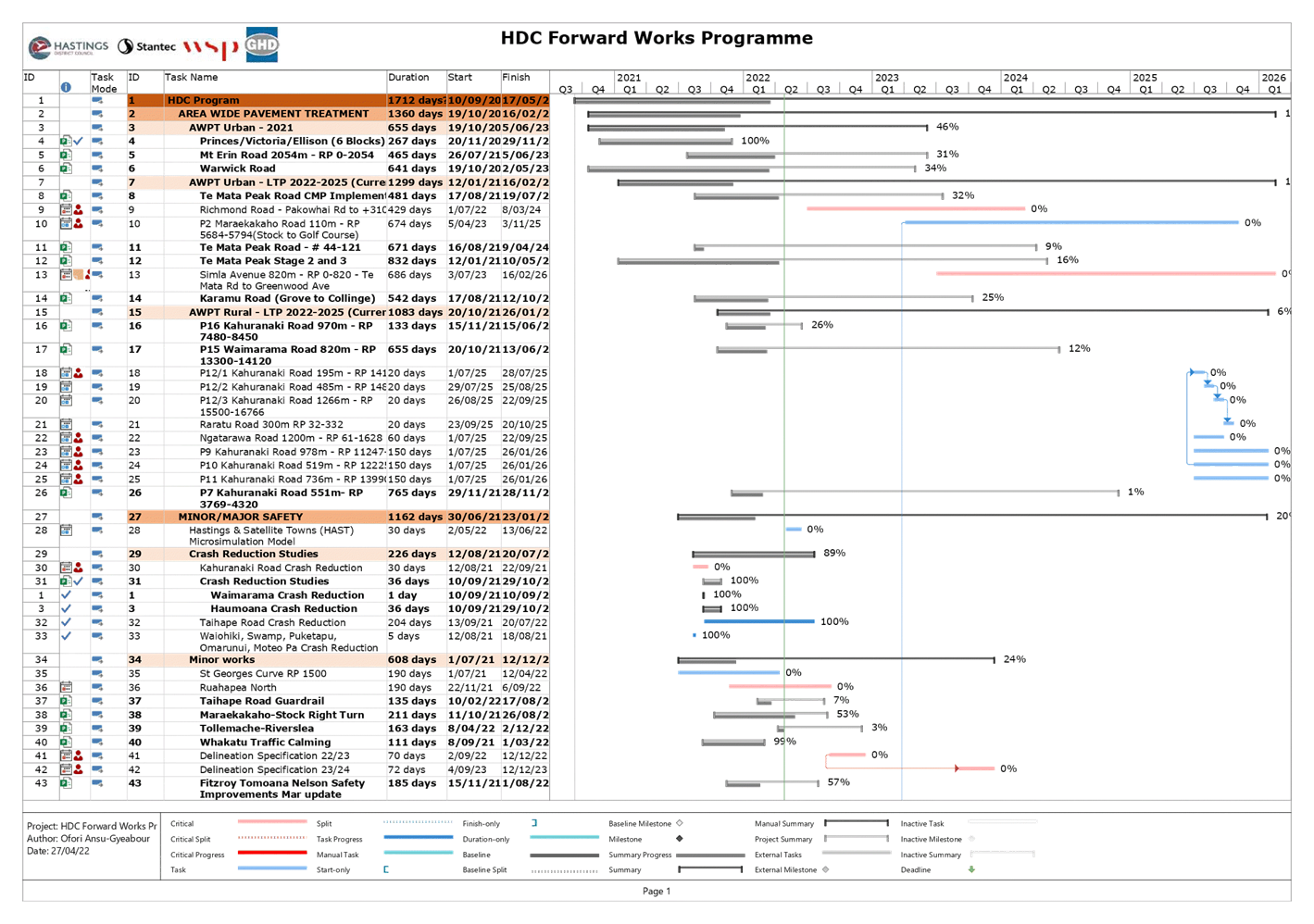
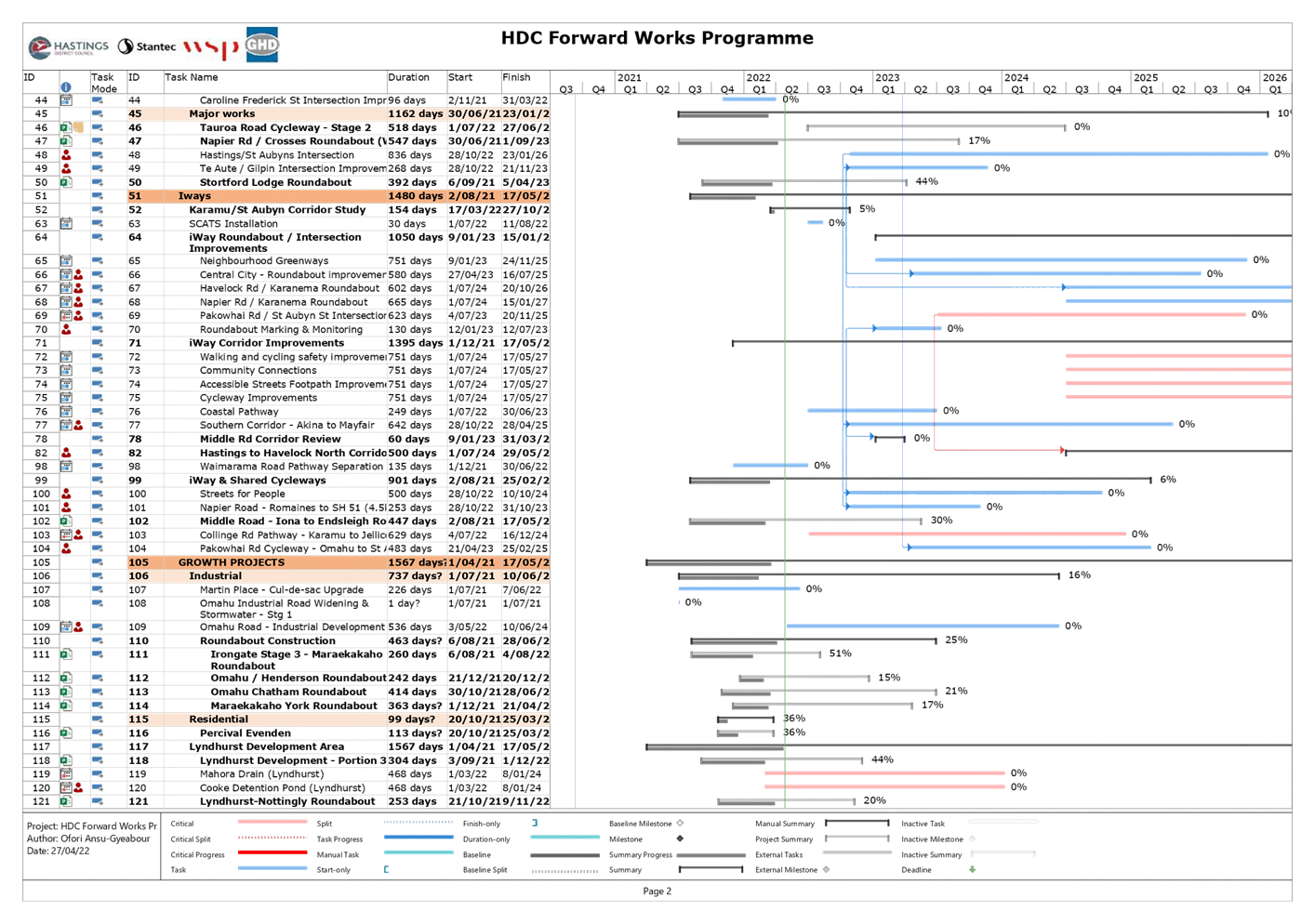
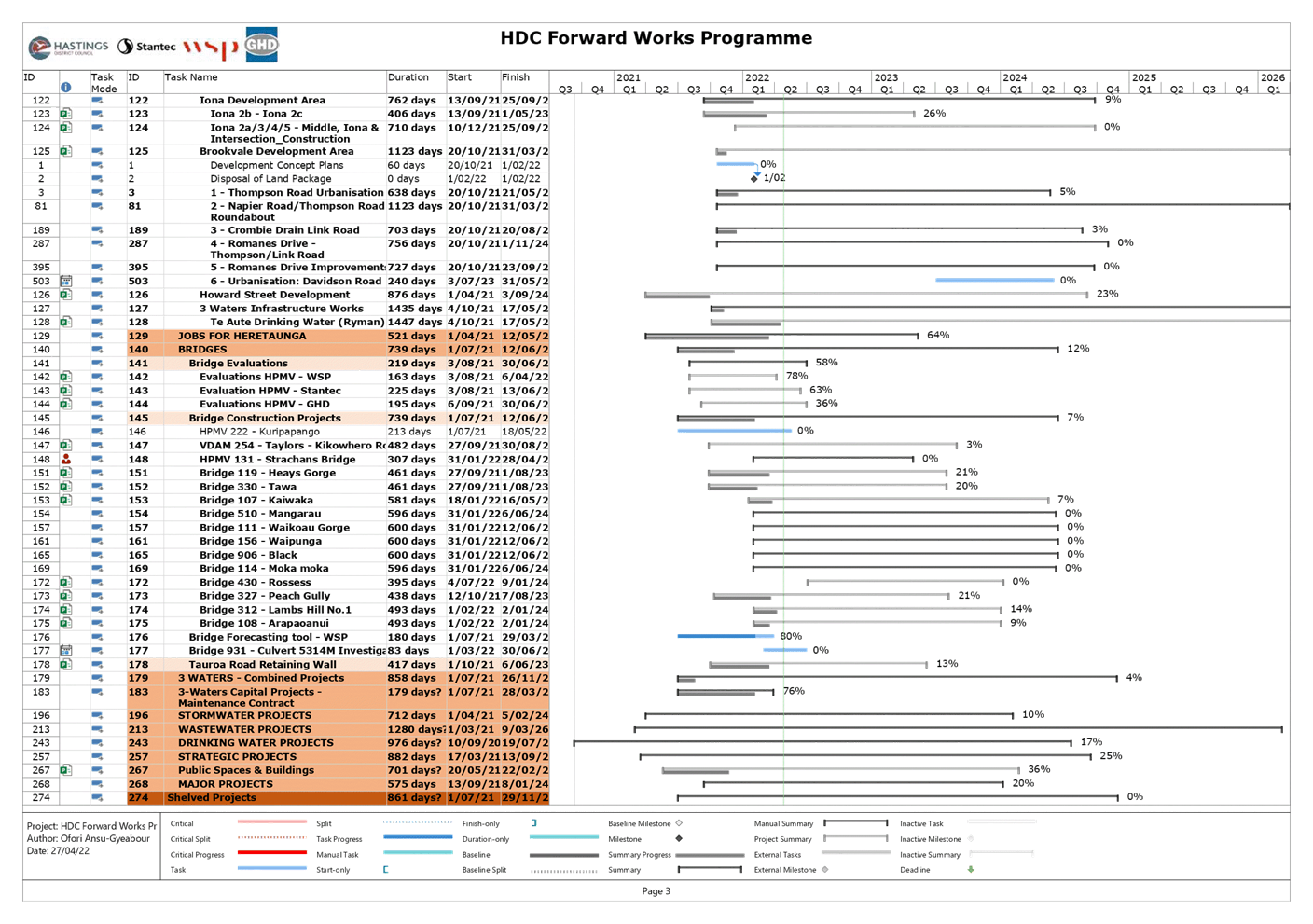
|
NCC forward work programmeMay 2022
|
Attachment
3
|
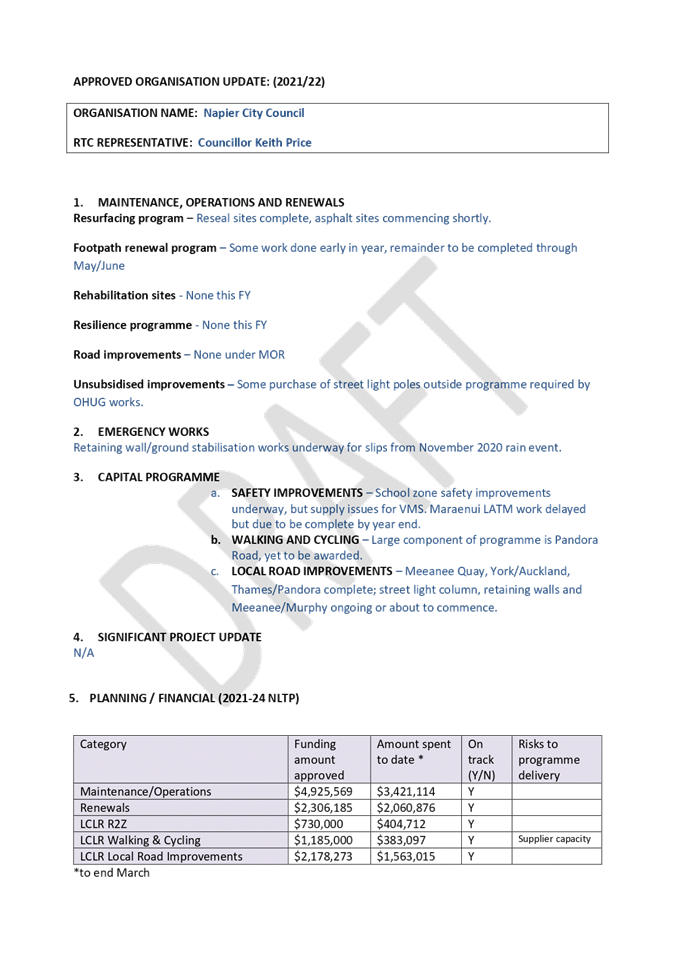
|
WDC forward work programme May 2022
|
Attachment
4
|

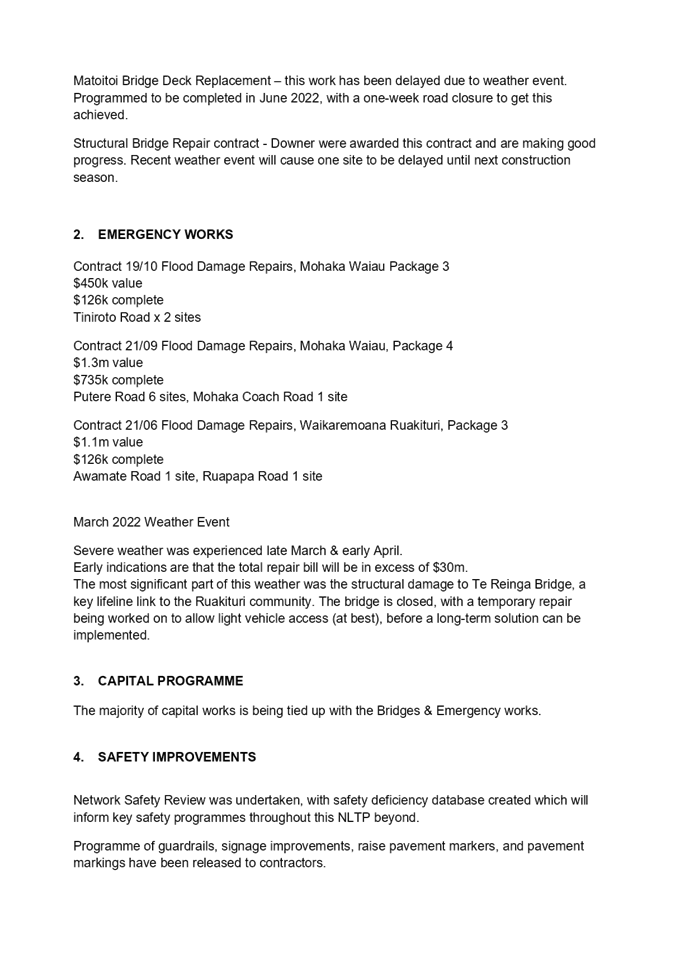
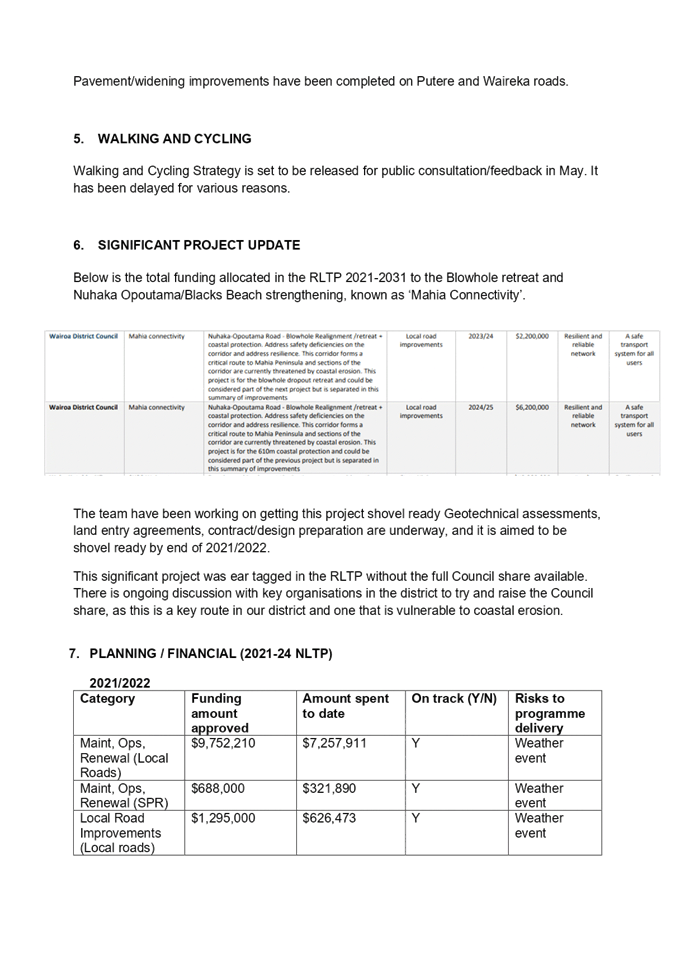

Hawke’s Bay Regional
Council
Regional
Transport Committee
10 June
2022
Subject: Gisborne Rail update
Reason for Report
1. This item presents the case
for the reinstatement of the entire Napier to Gisborne rail line.
Executive Summary
2. The Report titled Napier
to Gisborne Rail Line – Potential Reopening was commissioned jointly
by Hawke’s Bay Regional Council and Gisborne District Council for
submission to Government Ministers. It has been prepared by an independent
Project Team of consultants with oversight from a Project Team comprising
representatives from Hawke’s Bay Regional Council, Gisborne District
Council and Wairoa District Council, led by HBRC Regional Transport Chair Cr
Martin Williams.
3. The purpose of the report
is to seek funding from the Crown to carry out a business case to fully
reinstate the Napier to Gisborne Railway line.
4. It is intended to provide
Ministers with sufficient information to make a decision on whether to fund and
proceed to a detailed business case on:
4.1. the work and associated
investment required to reinstate/reopen the line from Wairoa to Gisborne
4.2. to assess any works needed
for greater resilience of the reinstated Napier to Wairoa line
4.3. or to declare the Wairoa to
Gisborne line closed and lift the rail designation.
5. Part of the rationale for
the report is to get a decision from Government on whether the line has a
future or not, which is the reason for the third option.
6. It was evident from the
Project Team interviews in Gisborne that there is frustration over not knowing
whether to plan for an eventual reopening, or if the line will be permanently
closed, particularly at a time of intense pressure on existing road transport services
to cope with the demands from steadily increasing primary sector production.
7. The genesis of this report
included that some members of the Project Team who had contributed to the BERL
Feasibility Study in 2019 were being approached to see if anything was likely
to be progressed on the reinstatement combined with an interest from KiwiRail
in getting an update assessment.
8. The report essentially says
that the line could and possibly should be reopened to provide for the growth
of the economies of the Wairoa northern Hawke’s Bay and Tairawhiti
regions and to provide a more efficient transport option to handle the growth
of primary sector product including for apples, squash and processed timber as
well as logs to the Port of Napier.
Background
9. The railway line suffered
considerable damage in 2012 that was concentrated along a 11km stretch of the
line in the Beach Loop area, and since then, it has deteriorated further
particularly through a lack of maintenance of drainage culverts.
10. The Hawke’s Bay
Regional Council has taken a leadership role in efforts over the last 10 years
since the line closed to gain the full reinstatement of the Napier to Gisborne
railway.
11. This included supporting a
Napier Gisborne Railway Establishment Group in 2013-14 chaired by then Regional
Transport Chair Cr Alan Dick, with business and iwi representatives in the
response to a call from then KiwiRail CEO Jim Quinn. The main forestry
representative on this Group is today’s main customer for the Wairoa Rail
Log Hub rail service.
12. Then in 2014-15 by the
Hawke’s Bay Regional Council developed the business case for the Wairoa
Rail Log Hub that led to KiwiRail reopening the line to Wairoa and running
regular log trains to the Port of Napier. The Council at the time also
advocated for the retention of the Wairoa to Gisborne line, including a
proposal to KiwiRail to lease the full length of the line from Napier to
Gisborne, with the aim of seeing the Wairoa to Gisborne section reopened
following the initial establishment of Wairoa Rail Log Hub rail services. This
Wairoa to Napier rail service is now well-established, operating on a five
day-a-week schedule.
13. The PGF BERL Wairoa to
Gisborne Rail Feasibility Study in 2019 estimated that the line could be
reopened for approximately $35million.
14. The Update Assessment
Report estimates the cost to be in the region of $80million and that is on the
basis of a more comprehensive investigation into every aspect, including the
addition of a tunnel to provide long term resilience in the Beach Loop area and
upgrading work on the Napier to Wairoa section.
15. This latest report is not
about “just open it and fix bits later”, but instead a view of
ensuring longer term resilience for the full length of the line from Napier to
Gisborne. This is what KiwiRail wants to see. Hence the increased cost.
16. The reason that this is
being raised now is that it needs to be considered along with a number of other
options in the context of climate change, rising fuel costs, social licence on the
road from increasing truck movements, and more efficient ways of conveying
freight to the Ports of Napier and Gisborne.
Napier
to Gisborne Rail Line – Potential Reopening
17. The detail contained in the
attachment 1 (Detailed Track Formation and Civil Construction)
concludes that the reinstatement of the line is feasible and the costings,
while early, are for building a resilient line which will stand up to the
relatively frequent weather events experienced on the East Coast. This includes
a tunnel to bypass the troublesome Beach Loop area and the use of a civil works
solution that has been used elsewhere on the KiwiRail network to repair the
dropout slips.
18. The preliminary estimate of
repair reinstatement costs is $73m to $80.5m, including upgrades to the Napier
to Wairoa section, as well as repair reinstatement of the Wairoa to Gisborne
line. $25m of this is for the tunnel work to bypass the Beach Loop slip area.
19. Ministers are requested to
fund $6.38m for the next stage of a detailed investigations business case,
which is split into 2 sub-phases. This is expected to take 6 months to
undertake.
20. This detailed business case
will include detailed assessments of bridges, tunnels, other structures and
track formation for the full line from Napier to Gisborne covering the specific
items that KiwiRail has requested be included.
21. There are significant
environmental and social benefits to reinstating the railway line, including
reduction of trucks in the central city of Gisborne, the capacity of the current
SH2 and reduction of trucks on Napier roads leading to the Port of Napier.
22. The freight assessment of
available rail freight contains known product from businesses which consider
rail as an option to road, including that this ensures they can more readily
transport higher quantities of loaded 40ft containers. It does not include what
appears to be an increasing volume of product coming on-stream in the near
future.
23. Major packhouses producers
and transport logistics operators have been calling for the reinstatement of
rail for the past 10 years. These parties are seeing the earlier predicted
growth in freight now happening and are dealing with an increasingly strained
trucking transport infrastructure.
24. This includes businesses
that favour switching to using rail to Napier, making greater use of fully
loading and sealing of 40ft containers in Gisborne at source rather than by
road to Napier or a longer trip by road to Tauranga for final packing of
containers for export.
25. The report also notes the
importance of the increased ability of larger container ships to use the Port
of Napier with the completion soon of the new Wharf 6 development, thus making
Napier more attractive for Gisborne exporters.
26. 150,000 tonnes of available
rail freight is projected for 2025 with this expected to rise to over 210,000
tonnes per annum by 2030.
27. Estimated projected gross
revenue in 2025 is for over $15m pa for the integrated rail with road
intermodal transport service, plus additional revenue from a significant amount
of inbound freight to Gisborne.
28. A critical issue facing
Gisborne is the major increase in transport infrastructure needed to provide
for scaled up timber processing. The report uses a conservative output figure
of over 450,000m3 per annum, noting that a possible processing plant capacity
to produce 600,000m3 is being considered. 450,000m3 equates to over 420 40ft
containers per week.
29. Well-being combined
benefits from reductions in GHG emissions, air quality impacts and reduced
vehicle crash costs total $1.04m to $1.54m per annum.
30. The report also recommends
that if the line is to be reopened, then the Crown needs to provide $200,000 to
clear blocked drains and overhanging obstructions to prevent further damage.
The damage to Beach Loop was largely as a result of a blocked culvert.
Strategic Fit
31. The Hawke’s Bay
Regional Land Transport Plan 2021-2031 sets out support for the region to:
advocate for the inclusion of the reinstatement of the Gisborne to Wairoa rail
line into the Ministry of Transport NZ Rail Plan 2021-24 (p 18); examine
opportunities for re-establishing the rail link to Gisborne (p 37); and to
advocate for and support the use of rail for freight (p 40). This also fits
with the Council’s climate change policies that aim to reduce GHG
emissions.
Tangata whenua/Māori Engagement
32. Iwi and hapu engaged within
the 2019 BERL Study were supportive of reinstatement of the line.
33. The Project Team included a
Gisborne based iwi advisor who had been involved with the BERL Study, who
undertook brief engagement with Turanga and Wairoa iwi/hapu within the
relatively short timeframe available for the preparing of the update
assessment.
34. If successful in attracting
investment for a detailed business case, the Project Team will be widened to
include representatives of Turanga and Wairoa iwi/hapu and in-depth engagement
and analysis of land development plans and aspirations.
Community
engagement
35. The Project Team visited
and engaged with interested stakeholders in Gisborne, Wairoa and Hawke’s
Bay including Port of Napier, although engagement was brief, given the short
time frame available to prepare this paper for submitting to Ministers.
36. Further in-depth engagement
will occur if the proposal for a detailed business case is successful.
Climate
Change impacts
37. The report considers the
benefits of reopening the rail line Wairoa to Gisborne in reduction of
emissions and reduced carbon footprint.
38. GHG emissions rail net
savings are estimated as 2,500 to 3,650 tonnes per annum.
Financial
impacts
39. Council’s
contribution of $30k to develop the Update Assessment Paper for Ministers has
been matched by a Gisborne District Council $30k with this funding from
operational budgets.
Decision Making Process
40. Staff have assessed the
requirements of the Local Government Act 2002 in relation to this item and have
concluded that, as this report is for information only, the decision making
provisions do not apply.
Recommendation
That
the Regional Transport Committee receives and notes the Napier to Gisborne
Rail Line – Potential Reopening update assessment report and covering letter.
Authored & approved by:
|
Graeme Carroll
Global Reach Associates
|
|
Attachment/s
|
1⇩
|
Letter to Ministers presenting
Gisborne Rail Reinstatement Assessment Report
|
|
|
|
2⇨
|
Gisborne Rail Reinstatement Update
Assessment Project Team Report
|
|
Under Separate Cover
|
|
Letter to Ministers presenting Gisborne
Rail Reinstatement Assessment Report
|
Attachment
1
|
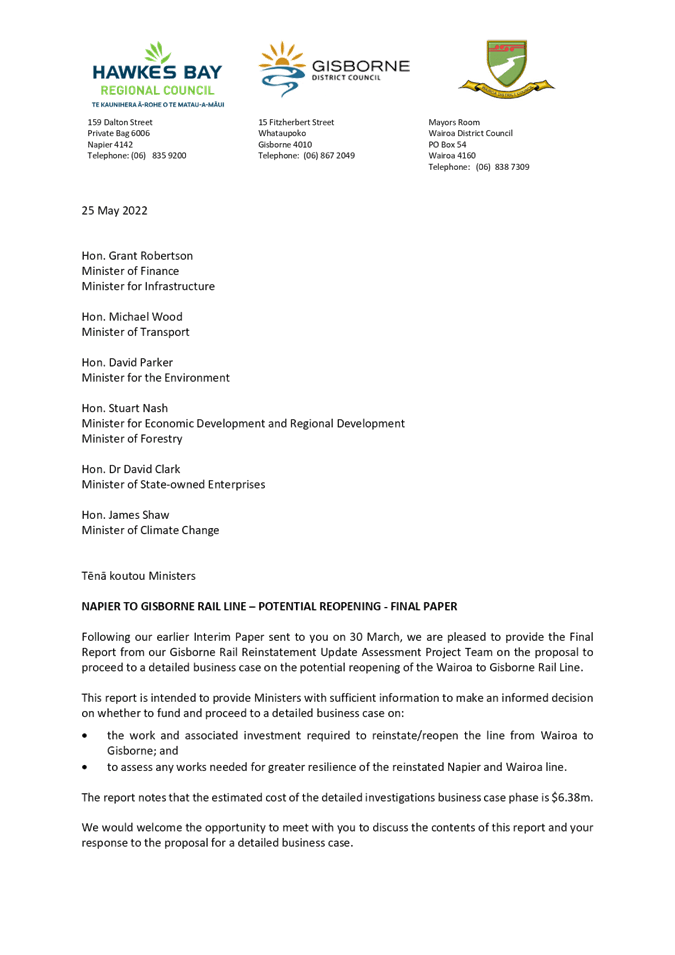
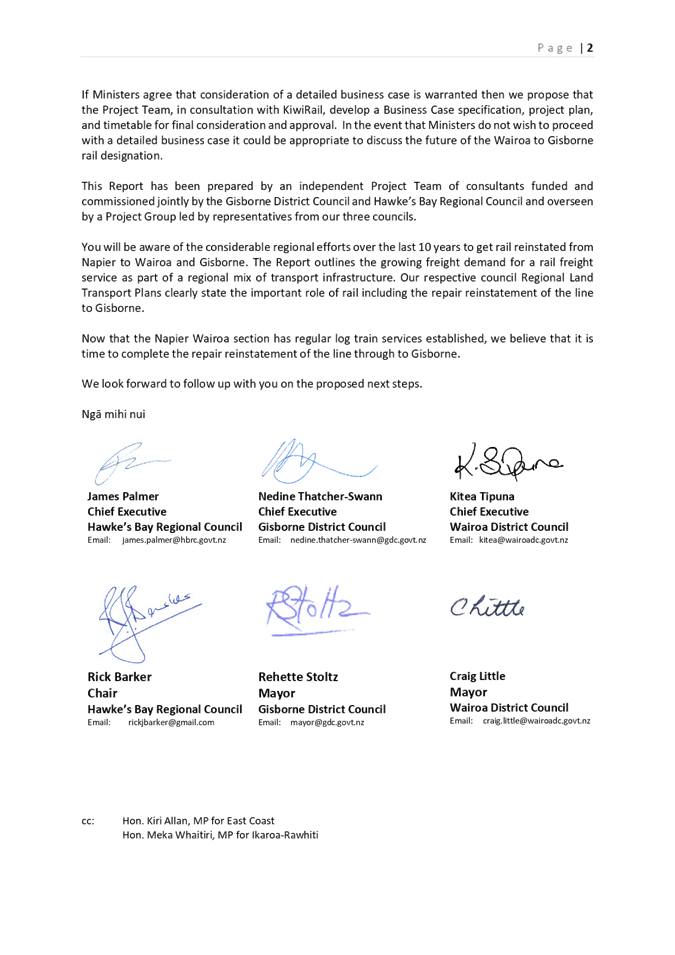
Hawke’s Bay Regional
Council
Regional
Transport Committee
10 June
2022
Subject: Discussion of minor matters not on the Agenda
Reason
for Report
1. This document
has been prepared to assist Committee members note the Minor items not on the agenda to be discussed as determined earlier in agenda item
5.














































